Filling the Gap

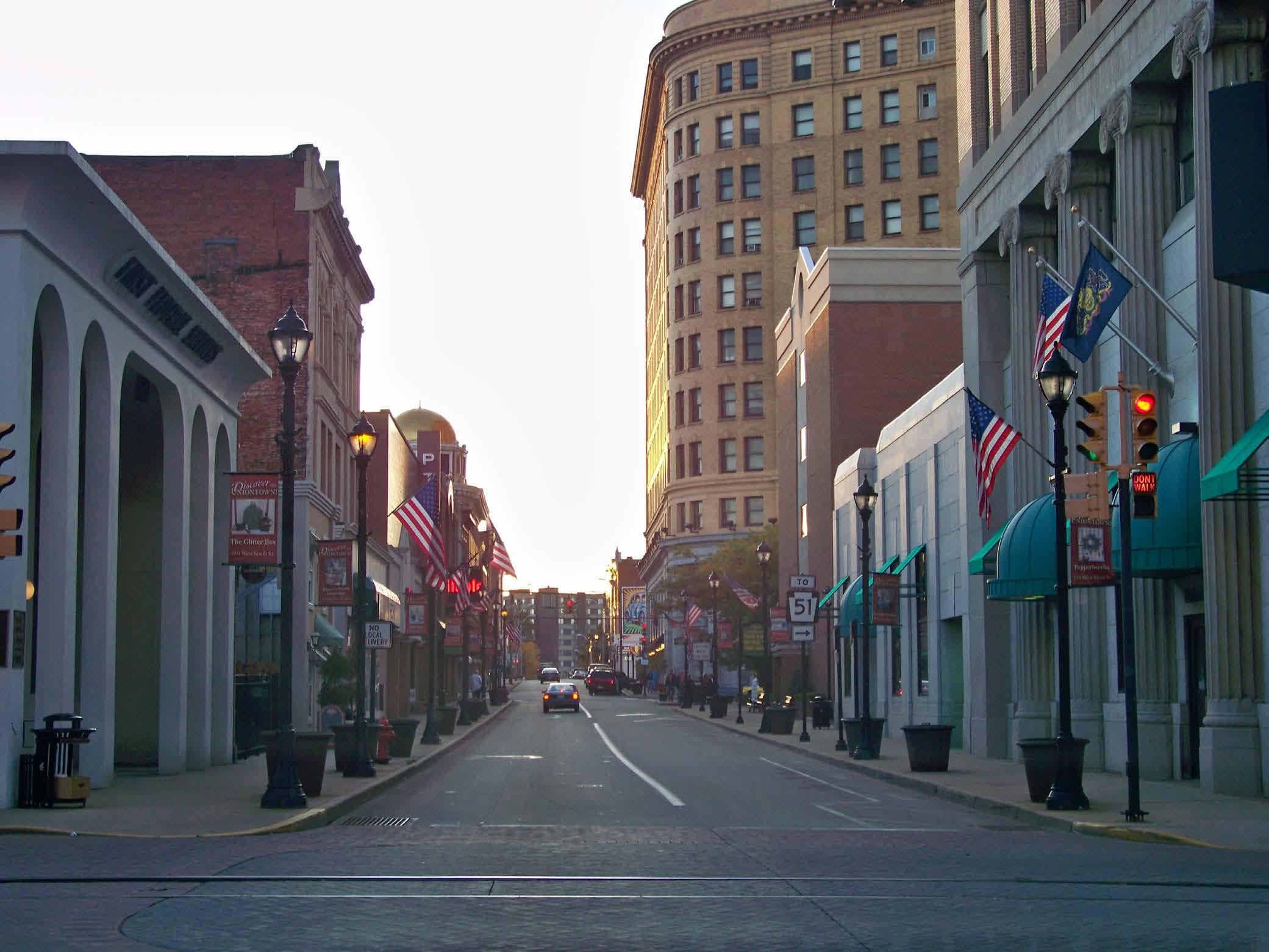



Our project consisted of three phases: research and current assessment, benchmarking potential funding and policy solutions, and presenting our findings and recommendations. We started the first phase by doing preliminary research on Uniontown to understand the community in broad strokes. We researched population demographics and statistics, as well as the recent challenges stemming from deindustrialization. Once we felt we understood the basics, we mapped the current assets along the entire proposed Sheepskin trail, and within downtown Uniontown. By doing this, we were able to locate potential opportunities for business. We have designated a "catchment” area along the trail that we believe is most relevant for investment and development. Within downtown Uniontown, we found an abundance of potential because many buildings are currently vacant and a significant portion of the land is being used for parking now.
Concurrently, during the first phase, we also engaged with stakeholders and community members in a visioning process. This allowed us to recommend solutions that reflect the needs and wishes of the community. We did this through multiple surveys, and also one in person visioning session. Throughout the visioning process, we heard many people voice their desire for Uniontown to be revitalized. While there were various ideas of how this would happen, because of the trail, recreational activities were often highlighted as a means to such revitalization.
Alongside recreation, many also talked about the need to create sustainable infrastructure to support such activities. These two ideas became the natural focus of the overall vision. With the input of the community, the vision statement became “Uniontown will develop the Sheepskin Trail in an effort to bring economic opportunities to the City, focusing on building sustainable infrastructure and recreational attractions. Uniontown will be revitalized, becoming a place people want to stay."
After deciding on the vision statement, we started the second phase. We began by researching benchmark cities that had similar histories to Uniontown, and recently found success as trail towns. We ultimately decided on 7 benchmark cities, paying particular attention to Connellsville, PA and Cumberland, MD. While researching what worked best in these benchmark cities, we also interviewed subject-matter experts in trail development. The benchmark cities gave us some ideas of what may work for Uniontown, and the subject-matter experts were able to put those ideas into context. The key takeaways from the benchmark cities were the importance of an intersecting main street, offering a unique experience, highlighting the historical significance, and hosting regular events to bring people together in town. The trail development experts advised to focus on low-hanging fruit in terms of both funding and policies that could be implemented, partnerships (both public and private), and that effective communication and coordination between community leaders is essential. Lastly, trail development experts encouraged investing in businesses within 4 categories: lodging, restaurants, retail, and entertainment.
Afterresearchingthebenchmarkcities,and consultingwithexpertsintraildevelopment, wedecidedwewere readytostartdrafting policyandfundingrecommendations.The policyrecommendationsweremadeonly afterconsultingthecurrentpoliciesin Uniontown,specificallytheteamlookedat themostrecentcitybudgetandspoketo MattThomas,CodeEnforcementOfficer.We ultimatelycameupwith3areasofpolicy recommendations:
LocalGovernmentAdministrative Structure: 1.
DevelopOfficeofCity Manager/Administrator
BusinessDevelopment: 1.
BusinessImprovementDistricttoretain existingbusinessesandattractnewones
LandUsePolicies:
ReformZoningCodefromEuclidean ZoningtoMixed-UseorForm-based Zoning
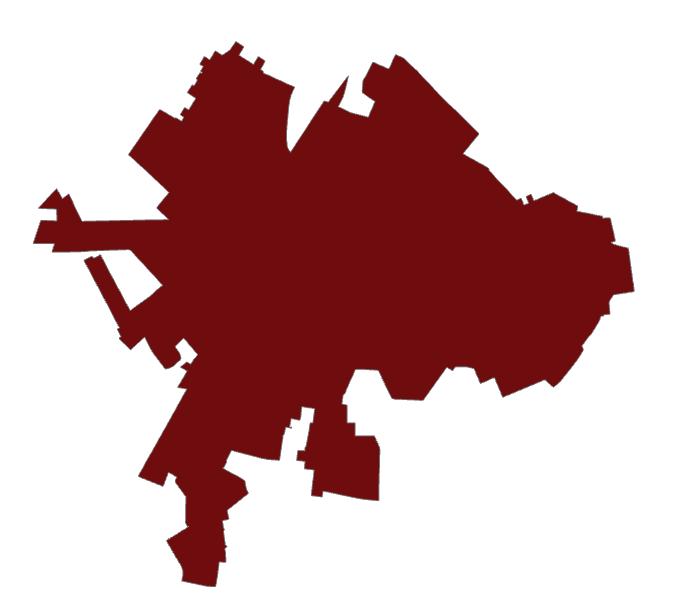
IncreasedUseofBenchesandParklets
AdaptiveRe-useofBuildings
RepealParkingMinimums CommunityCode-EnforcementProgram CompleteStreetsPolicies
Finally,wecreatedaninventoryof publicand privatefundingopportunitiestheCitycan usetorealizesomeofourrecommendations. Wehavehighlightedfivepublicfunding opportunitiesfromtheDepartmentof Community&EconomicDevelopment,the KeystoneCommunitiesProgram,the DepartmentofConservation&Natural Resources,andlastlytheDepartmentof Transportation.Regardingprivatefunding opportunities,wecreatedasmalldatabase ofgrantsandorganizationsthatwebelieve bestsuited fortraildevelopmentprojectsin Uniontown.
Becausegrantmakingissuchanarduous, butimportantprocess,werecommendthat thecityhiresanadditionalperson,acity manageroradministrator,tohelpwiththat specifictask.Thispersonthencouldprovide agreaterpublicservicefortheentire communityofUniontown.Weoutlinedthe grantproposaldevelopmentprocess,and haveprovidedadditionalresourcesinthe appendix.
Uniontown once was a thriving industrial hub that relied on the steel and coal mining industries, creating thousands of well-paying jobs and tremendous wealth. In the early 20th century, Uniontown even had the most millionaires per capita in the country. But like many small towns in Pennsylvania, Uniontown has since experienced decades of deindustrialization and population loss.
As jobs became scarce, thousands of people fled for other economic opportunities. Sadly, many of these people never returned. Uniontown’s population peaked in 1940 at 21,000 people. Today, it is home to fewer than 10,000 as depopulation slowly continues.
The Sheepskin Trail will eventually connect the City of Uniontown to the Great Allegheny Passage (GAP), a 150mile bicycle trail responsible for generating $80 million in tourism revenue. Once it is completed, the City has the opportunity to revitalize its postindustrial economy and improve the quality of life for its residents. The City will be prepared to take advantage of this recreational asset and use the Sheepskin Trail as a catalyst for economic growth.
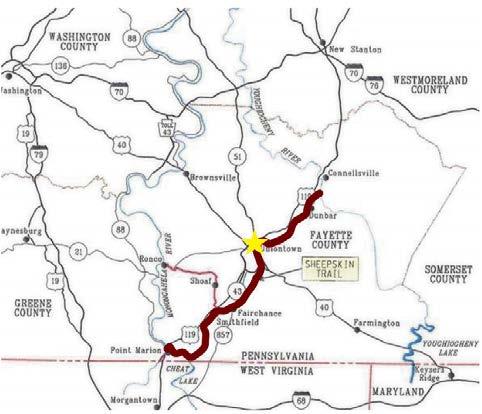
Attract new employers along the Sheepskin Trail, build sustainable infrastructure, and improve the health and wellbeing of City residents. Ultimately, the City can transform itself into an archetype for other small postindustrial communities with the opportunity to utilize their recreational assets.
The mountainous location in the beautiful Laurel Highlands has always been integral to the city’s success. Although the mountains no longer are home to bustling coal mines, they still present Uniontown with unique opportunities to grow its economy through outdoor recreation and tourism. Specifically, the completion of The Sheepskin Trail will allow visitors to tour the beautiful Laurel Highlands before stopping in Uniontown to shop, eat, and stay overnight.
While the completion of the Sheepskin Trail alone will not be enough to revitalize Uniontown entirely, it is a step in the right direction. Uniontown’s rich history, architectural beauty, and established main street serve as a strong backbone to becoming a successful trail town, a city that is attractive for visitors and locals alike
Our project recommends trailbased development strategies to achieve the following goals:
To kick-start our background research, we conducted a stocktaking and visual mapping of current assets at Uniontown’s disposal.
These assets would complement the Sheepskin Trail and contribute to the economic development that the traildevelopment would entail. We specifically looked at physical assets related to the tourism sector such as hotels/lodgings, restaurants, and commercial centers. We also took stock of historical and cultural assets that would pull trail enthusiasts to Uniontown, such as the historic downtown and regional points of interest e.g. birthplace of Gen. George C. Marshall (former Secretary of State and eponymous with the Marshall Plan). Finally, we conducted a spatial analysis of the Uniontown’s location within Fayette county to identify proximate locations that would benefit from the development of the Sheepskin trail and vice-versa, such as historical industrial locations close to Uniontown e.g. Lamont Furnace.
Figures 1-3 illustrate the current assets in Uniontown most relevant to the Sheepskin Trail.
The Sheepskin trail lies approximately on the existing rail-link passing through Uniontown and connecting it with Dunbar to the north, which provides connection to the Greater Allegheny Passage (GAP) trail near Connellsville (Fig. 1). Development of the Sheepskin trail relies on coordination with municipalities adjacent to Uniontown, and the long-term success of the trail will also rely on cooperation with these municipalities.
Being the seat of Fayette County, Uniontown enjoys certain administrative and legal privileges that allows it certain influence that it will look to utilize in the future.
While not directly connected to Ohiopyle (the major tourist destination and one of the largest centers of economic activity and employment south of Pittsburgh) through the Sheepskin trail, Uniontown’s proximity does allow it to leverage Ohiopyle’s tourist traffic and attract repeat visitors to the trail.
During the course of our asset mapping, we overlaid locations of restaurant/cafes and hotels from online sources on the Downtown Uniontown map (Fig. 2). A closer look at the commercial zone shows a significant number of cafes/restaurants to cater to the Sheepskin trail, but fewer hotels in the Downtown location. This presents an opportunity for trail-centric development in the downtown area, especially in the empty or abandoned buildings that were witnessed during our team’s visit.
Looking at the larger potential trail path, we have identified existing assets and a ‘catchment area’. This area represents the geographic area we believe to be most relevant for development of the Sheepskin Trail.
This current geographic analysis shows us there are numerous opportunities for development along the proposed Sheepskin Trail. Uniontown itself is located in the beautiful Laurel Highlands, and it’s close to popular tourist destinations like Ohiopyle. With the Sheepskin Trail, Uniontown can become a new destination for tourists of this already popular area. Next we will be zooming into downtown Uniontown.
Fig 1. Uniontown and adjacent municipalities in Fayette County

Fig 2. Downtown Uniontown with tourism-related assets

Fig
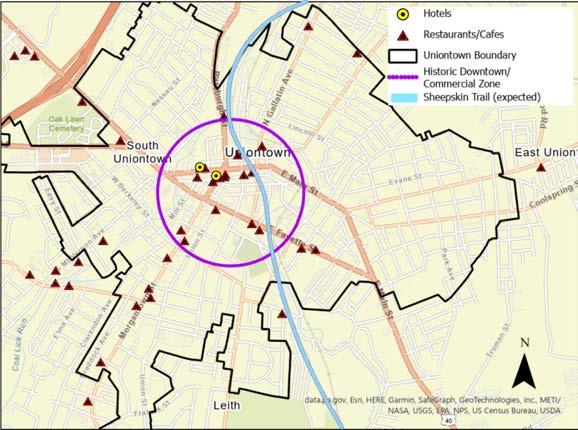
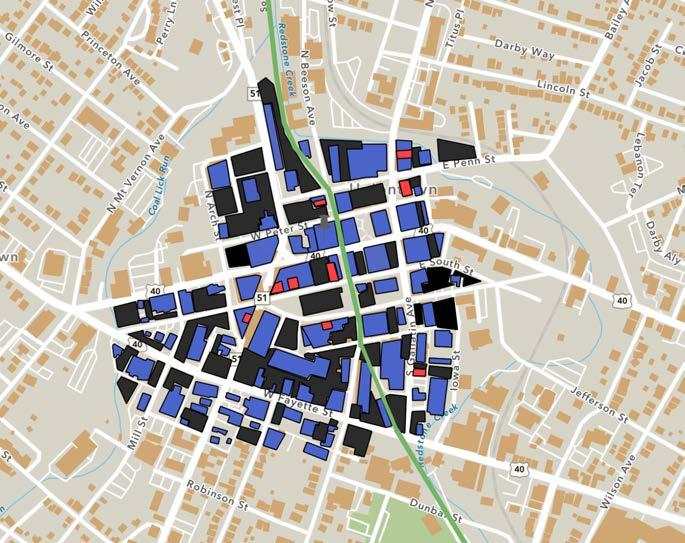
Blue - Existing commercial, housing, and cultural buildings
Green - Existing green spaces and future route of the Sheepskin Trail Red - Dilapidated structures that could be repurposed, refurbished, or otherwise renovated Black - Vacant land, parking lots, and parking structures.
Based on our analysis of current land usage in Uniontown’s Historic Downtown (bounded loosely by Penn, Gallatin, Fayette, and Morgantown Streets), there are plenty of opportunities for business development. Especially because approximately 40-50% of land in the downtown area is surface parking lots.
All investment opportunities within Uniontown must have the support of Uniontown residents for them to be successful. This is why we conducted multiple surveys, one with the broader public and another specific to the advisory board. We also held multiple visioning meetings with different members of the advisory board to ensure as much community involvement as possible.
As a part of our research phase, we conducted a survey of Uniontown stakeholders to help inform a project vision that fits with the with the community's goals.
Our team elected to use Qualtrics as the host for the community survey and distributed the survey link to the advisory board directly (snowball sampling). The advisory board members were leverated to further distribute the survey to forums based in or near Uniontown (convenience sampling). The majority of our respondents came from one of the following sources:
Sheepskin Trail Facebook Group
Various Uniontown Facebook groups City Urban Redevelopment Authority Business District Authority
Personal Facebook pages
Uniontown Neighborhood Crime Watch Local radio station (WMBS)
The survey received more than 450 responses. The vast majority of respondents finished the survey during a one-week period: February 25, 2022, through March 4, 2022. While reviewing the demographics and responses, we remind readers that these respondents answered our survey in a selfselected fashion. A self-selected sample will bias our responses because only those already willing to take the survey did. Given the nature of the survey (the Sheepskin Trail), we can anticipate that those filling out the survey will be biased toward an appreciation for the trail.
Of the respondents, almost two-thirds are female, one-third are male, and the remainder report “Other” or “Prefer not to Say.”
Overwhelmingly, our respondents were white (95.6%) which over represents the white population by 24%.[1] As Uniontown continues to move forward with development, we recommend further outreaching to ensure a more balanced population. We also observed two peaks in respondent age around 35-44 and 65-74 years old, with the former being larger. These age peaks are consistent with anecdotes made by the advisory board as well as empirical data (provided in the Appendix).
More than 80% of respondents use the trail at least once a month, but the survey’s self-selection property adds some complexity to this metric. Most of our respondents are Uniontown residents, but also our survey’s distribution focused heavily on populations that most likely already knew about the Sheepskin Trail. Despite these biases, it’s very encouraging to see the heavy usage of the trail when it is not yet complete within city limits. Additionally, 50% of respondents use the trail at least once a week. The remainder of the respondents (~18%) either rarely (once a year) or never use the trail.
When asked how respondents use the Sheepskin Trail, the top results were walking, biking and running at 52%, 25%, and 14% respectively.
These results are predictable, align well with the advisory board’s anticipated usages, and match the aspects of the trail that respondents already enjoy.
In addition to walking and biking, respondents enjoy the scenery, safety, and accessibility that the Sheepskin Trail provides. Interactions with fellow trail users are mentioned as a positive aspect of the trail as well. Alternatively, we ask respondents what features would encourage them to use the trail more; overwhelmingly, respondents list “trail length and connections.” This is a broad generalization, but respondents hope to see the Sheepskin Trail completed in Uniontown, wish to see it extended where possible, and want connections to other trail systems. Because overall survey results are heavily biased towards advisory board members and their closest communities (due to self selection bias), we recommend gathering feedback from other non-trail related communities during the development of the trail to better understand the needs of those that do not already use the trail.
Survey respondents are asked about the recreational activity, public service, and employment needs of Uniontown.
Recreational requests by respondents diverge significantly from those of the advisory board in some key regards. Respondents agree that Uniontown needs parks, community events, and biking amenities but would like to see specific sports and activities supported, namely skate parks, a community pool, and tennis courts.
These three requests are frequent enough to stand out against more general requests for “biking” and “community events.” As such our team recommends careful consideration of these community requests.
With regards to public services, respondents and the advisory board are more closely aligned. Respondents feel public parks, safety, parking areas, and public transportation are very important. This is the second time parks are requested within this section of the survey and we feel the advisory board should consider this significant. Recreational needs are asked before public service needs, but despite this we see a heavy focus on parks in both. Safety is also a recurring theme within the survey, but rarely do respondents go into more detail concerning what ideal safety looks like or how it is enforced.
Respondents again diverge from the advisory board concerning the employment needs of Uniontown. In order, respondents would like to see manufacturing, technology, small business, public service, and tourism jobs in Uniontown; manufacturing far outstrips the other categories and tourism is last. Some measure of difference is expected between the two groups as the advisory board is concerned with the Sheepskin Trail development first and believe that tourism is the best route to supporting the trail in the short term. Although, the sample population represented in our survey are also very focused on the trail and its usage. This divergence between two trail-focused groups represents an opportunity for further synchronization with the trail-using community. Our group recommends exploring this relationship further to ensure that the community’s needs are met and grow alongside the trail.
Althoughsurveyrespondentsdifferfromthe advisoryboardinsomekeyregards (employmentfocusandrecreational activities),wefeelthatthetwogroupsare mostlyinsync.Respondentsareaskedto considerhowSheepskinTraildevelopment shouldbealteredorchanged.
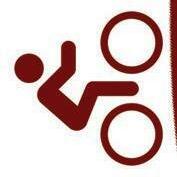

First,respondentsfeelensuringsafetyisthe numberonepriority.Asmentionedbefore, thedesireforsafetyisleftgeneralbymost respondents.Second,respondentswould liketoseethetrailextendedorconnectedto otherregionaltrailsystems.Third,thetrail shouldincludeamenities(restrooms, benches,etc),bikeaccess/support, recreationalareas,andhistoricalareas.None oftheseareasareparticularlydivergent.
Fourth,respondentswouldliketohavea moredirectrelationshipwiththetrail developmentprocess.Thisdesireis expressedinmanyways,butcanbe summarizedintwopoints:Transparencyand communitycontributions.Duringthe visioningsessions,theadvisoryboard discussedwantingthecommunitytohelp activelymaintaintheSheepskintrail;based onrespondentresults,werecommendthis formofcollaborationandencourage forward-thinkingbetweentrail-usersandthe advisoryboard.Ontheotherhand, transparencyaroundthedevelopment processhasnotcomeupindiscussionmuch withtheadvisoryboard.Westrongly recommendtransparencyfromUniontown basedontherequestsbyrespondentsand ofcourseintheinterestofaccountability.
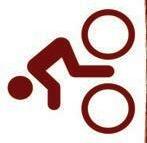
As a part of our investigative phase, we researched benchmark communities with past efforts that are in line with Uniontown's goals.
Uniontown can replicate other small towns’ successes to make the most of having access to a rail trail. In successful trail towns, there is an effort to incorporate the trail with an existing feature of the town to best make use of it. Among the towns assessed, a few communities along The Great Allegheny Passage (GAP) were seen as suitable examples to draw parallels from. These areas had suffered from population decline and economic disinvestment for several years and reaped wide success and economic benefits for residents and business owners after adapting a ‘Trail-town’ mentality.
The following are examples of successful efforts of integrating a rail trail with a town’s existing assets.
Connellsville, PA
Cumberland, MD
Meyersdale, PA
Harper’s Ferry, WV Confluence, PA Boonville, MO
Connellsville was the coal and coke capital of the world with a wealthy heritage. Similar to Uniontown, the town saw a decline in population and opportunities for economic growth and their biggest asset was location: proximity to Falling Water & Seven Springs.
However, what has enabled a rhythm of functioning synergy is investment of time and resources within the community by the local chapter. The local chapter is responsible for ideation and implementation of projects along the trail in terms of business development, activities for residents and ensuring that the city management is in the loop. Through their efforts, Connellsville is looking at building a micro-resort in the near future to attract more GAP users.
In Cumberland, MD, the GAP intersects the C&O Towpath to form a natural landing spot for many tourists. The town’s main street, Baltimore Street, conveniently connects to the trails, allowing visitors to easily access the local offerings. Baltimore Street is lined with rows of beautiful 19th century buildings, similar to downtown Uniontown, that are inviting for both overnight visitors and those stopping in town for a quick lunch. Uniontown can follow Cumberland by creating a convenient connection between the Sheepskin Trail and its main business district.
In Meyersdale, PA, Morguen Toole Company is a popular hotel, restaurant and event center which attracts many overnight users. It is a restored 19th century building which preserves its historic charm and offers visitors a quaint destination where all their needs are met. During the pandemic, it opened a food truck to adapt to the circumstances and still offer Morguen Toole’s American-style dishes.
ScenicHarper’sFerry,WV,hasaccessto boththeAppalachianTrailandC&O Towpath,providingtrailusersaccesstovisit thehistoricalsite.Here,userscanvisitacivil warmuseumandothermonuments. AlthoughUniontowndoesnothavealarge fortlikeHarper’sFerry,itisnonetheless historic.Uniontowncantellitsstoriestotrail usersandserveasahistoricaleducationfor steelandcoal-basedsmalltowns.

TheConfluenceTourismAssociationhas madeeffortstowardsincreasingtheirdigital marketingcontenttobenefittrail communities,businesses,andorganizations. Giventhatitwasasmallmunicipalitywith limitedstaffandtechnicalsupport,there havebeenproposalsfortheGAPtodeploy sharedresourcestohighlightcommunity resources.
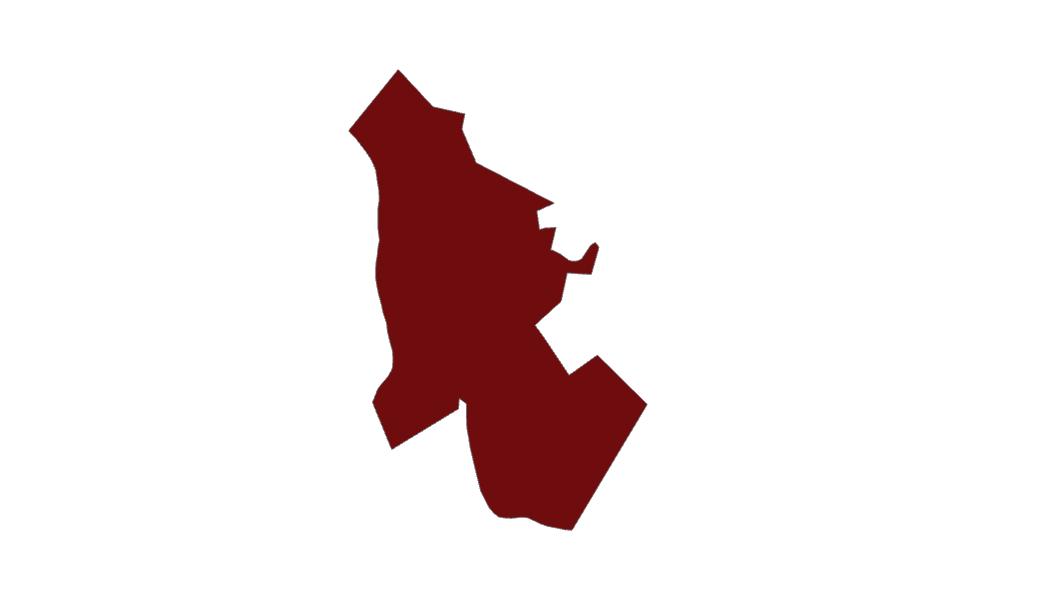
Hostingcommunityeventsalongthetrail Boonville,MOislocatedinthemiddleofthe KatyTrail,thecountry’slongestrecreational railtrail.Thetownhasrecognizedthe potentialtobuildcommunityaroundthetrail andincorporatesitintocommunitywide events,liketheFestivalofLeaves.Notonly doesthispromotecommunityinvolvement, butcanalsoattractpeoplefromnearby communitiestovisitfortheevents.
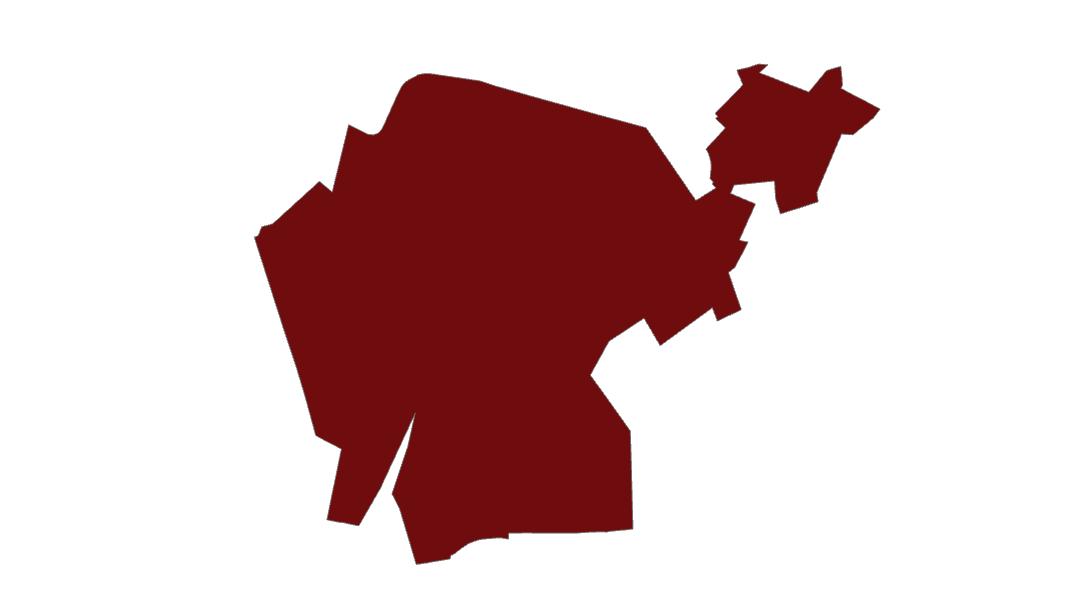 Connellsville
Confluence
Meyersdale
Connellsville
Confluence
Meyersdale
As a part of our investigative phase, we interviewed regional trail based economic development experts to help inform the vision.
Bryan Perry, Executive Director at Great Allegheny Passage Conservancy
David Kahley, Executive Director at The Progress Fund
Cathy McCollom, Founder of McCollom Development Strategies
James Price, Senior Program Manager at Sustainable PGH
Amy Camp, Founder of Cycle Forward
Michael Edwards, Executive Director, Redevelopment Authority of Connellsville
Keeping the scope of the project in mind, the ‘Nature-based Placemaking’ (NBP) emerged as a suitable methodology to recognize and adopt existing assets as a generator for economic activity. NBP entails the connection of civic, tourism and business by enabling a connection and collaboration within areas of focus within residential concerns, guest services and business improvements. In this context, the existing assets might include residents’ skills, historic architecture, cultural elements, local businesses, and general quality of life as a focus to build long-term value and attract a range of further investments along the Sheepskin trail.
Underutilized retail space and buildings, a lack of signage and wayfinding, an avenue for convenient parking, as well as residential support in terms of creating demand for businesses were central elements uncovered in conversations and the visioning process for a thriving downtown area;
to attract both residents and tourists on the trail. A deeper-dive with subject-matter experts paved the way for a more comprehensive analysis of systematic improvements along a trail. Each of these impediments would require varying strategies to meet the stated goal for Uniontown. The following sections will explore policy tools and actions to support workers, businesses along the trail to eventually improve the quality of life of the residents in question. The team is optimistic that this inventory will further enable staff to develop innovative programs as needed in the future.
Significant emphasis was placed on creating a robust economic development strategy that not only attracts trail enthusiasts, but involves and serves residents for long term sustainability. Multiple partners in the form of municipal governments, non-profit organizations, volunteers seeking to contribute and revitalize communities as well as key stakeholders within Uniontown’s city management must unite around a common goal. Only with this communal mindset and with concerted effort can the area begin to explore potential approaches toward economic development. Three critical precursors to policy have been identified for Uniontown:
There needs to be a focus on areas of opportunity that are both achievable and tangible. Incremental steps that introduce visible improvements will be the most effective when investing community resources, funding, and time to create a sense of economic vibrancy.
Practical urbanism on the local front, short term projects for infrastructure, and creating connections between trails and towns to ease the flow of transitions into and out of the city are a few compelling examples.
A mechanism must be created to identify funding for different types of projects and reliable partnerships across public agencies. This means that goals must be defined precisely and aligned with specific funding sources to improve the odds of securing it for implementation.
This is required to achieve a higher percentage of community goals with a common force behind it. Groups with limited resources must avoid redundancy and conflicting efforts for meaningful improvement. In Confluence, local businesses have formed a Tourism Association that has a purposeful group of people focusing their efforts on bringing new people into town, a separate chamber of commerce for business initiatives and a group of volunteers that are solely responsible for activities along the trail.
Additionally, with respect to specific suggestions made for trail towns, a common theme emerged in conversations following the life of a ‘biker along the trail’. Most frequent needs of a traveler are categorized under the top four recurring essentials:
Specifically, Bed & Breakfast (B&Bs) and guest houses were a key asset along the Great Allegheny Passage (GAP). Interviewees stressed on the ‘originality’ of an inn as a main attraction for tourists seeking a ‘warm and personalized experience’ characteristic of the town. This could be achieved by the local community involvement and contribution in the form of art installations
and cuisine served at the facility. Given the expected location of the trail, this could also serve as a means to draw people into downtown.
Overnight guests and daily visitors need a variety of eateries to choose from. Travelers seek a physically ‘interesting’ place with history and one that holds meaning for locals. According to Bryan Perry, “the first thing one wants to do after a tiring bike ride along the trail is find a good place for a sandwich, wrap or drink”. Further positives to create a “good vibe” would be live music, entertainment, or a theme to create a distinct ambience.
In terms of revitalizing the shopping district while keeping a few aspects of tourism in mind, a bike shop was a unanimous suggestion from the experts. A place where bikers can go to buy a piece of gear or equipment that might have been faulty on the journey, get their brakes/medals adjusted, or possibly exchange their bicycle for a new one. A souvenir shop, winter clothing, organic food stands, and boutique crafts were also a few of the many notable ideas.
Experts recommend that it is important to highlight something that is unique to a town. Uniontown needs a place like a passive public green space, patio, or a series of events that could draw people in over weekends. This could take the shape of an outdoor music, live theater, or a characteristic festival. For example: Meyersdale hosts a Pennsylvania Maple Festival that draws a crowd from all over the country; there’s a parade, pancake eating contest, and even the crowning of a maple queen! Another benchmark city, Confluence, has a Pumpkin Festival.
A similar draw might be public art or installations. A local mural tour, a sculpture garden, or fountains could all be a part of a planned historical tour for a visitor through which Uniontown could market its reclaimed industrial heritage and give people a reason to ride off the Sheepskin Trail and into town. An Original Art Mural Permit might be required for murals that are installed using the standards included in Title 4 (Original Art Murals) and Mural Administrative Rules. Onsite work on the mural cannot begin until the permit is issued. See an example of regulations for an original art mural in Portland, Oregon in the footnotes.[2]
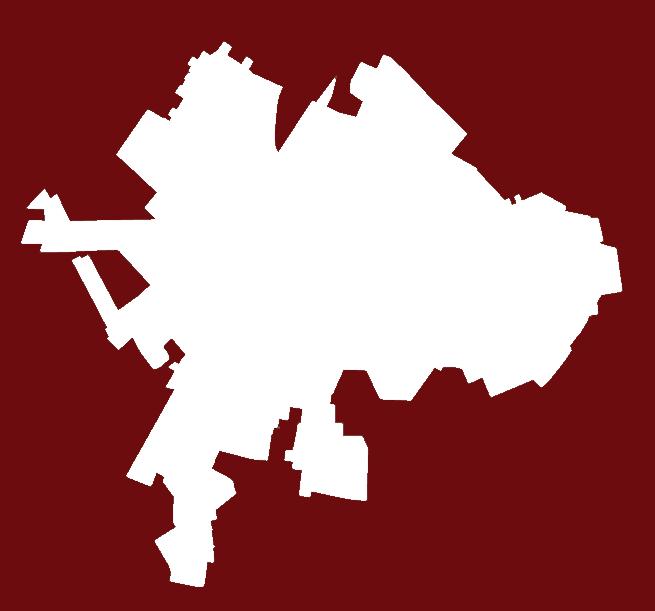
In line with our primary and secondary research which included current state analysis, visioning sessions, surveys, expert interviews and case studies, the team prepared a list of policy and funding recommendations for Uniontown.
The policy recommendations are divided into three overarching sections: Local Government Administrative Structure, Business District Development, and Land-Use Policy.
The funding recommendations are divided into two categories; public and philanthropic. The recommendations are intended as a starting point to identify the tools and resources that are available locally and are best suited to the context and goals of the community as a whole.
The recommendations are intended to help Uniontown and Sheepskin Trail stakeholders develop new and innovative strategies and programs over the next 5 years to help achieve their vision of a revitalized Uniontown.
It is our strong recommendation that Uniontown consider creating an Office of the City Manager/Administrator in order to create greater governmental efficiencies and to expand the resources available to Uniontown. As it currently stands, there is no professional executive leadership at the City, leading to inefficient administration of public resources.
City Managers oversee the day to day business of local government. Appointed by Council, City Managers ensure that the local government is being administered technically, efficiently, and transparently. Like private sector businesses, City Managers provide direct, executive leadership so that department heads all have a single point of leadership and are able to coordinate each department's resources to maximize efficiency.
A City Manager will be able to help Uniontown better manage financial and human resources; oversee delivery of essential services; oversee implementation of the comprehensive plan; improve datadriven decision-making and project implementation; ensure all ethical, financial and legal guidelines are being adhered to; and also work with local partners to develop grant proposals and additional funding streams to help Uniontown achieve its goals. [3]
The placement of a City Manager will also help Uniontown become a stronger candidate for receiving State,
Federal and philanthropic funding, as grant makers like to see evidence of strong executive leadership in place when making funding decisions.
Chapter 112A of the Third Class City Code provides City Council the authority to enact an ordinance by majority vote to establish the Office of City Administrator/Manager.
The Department of Community & Economic Development (DCED), through the Governor’s Center for Local Government Services (GCLGS) provides technical assistance to municipalities for fundamental projects, including developing administrative capacity. A copy of the application is available in the Appendix of this report, though the online application is recommended.
A Business Improvement District (BID) is a legally set aside zone in which businesses must pay an additional tax, fee, or levy to contribute to maintaining and developing or for common marketing of their district. The districts are areas within a municipality where some form of revenue generation is legally enforced to provide services for the area, beyond those offered by the municipal and county services. A street cleaner, kiosk with names and addresses, façade improvement, a gardener to water the plant are a few examples of the use of the collective money to improve the sense of a place and empower local property owners as well as businesses.
Though the process of creating a BID can on face value seem controversial due to the tax levied on businesses, research has shown that BID can increase property values for building owners, increase foot traffic into businesses, and therefore, increase earnings for small businesses due to a more inviting shopping environment.
Title 53, Subpart A, Chapter 54, known as the Business Improvement District Act of the Pennsylvania Consolidated Statutes, provides municipalities the authority to develop a BID and outlines the regulations therein.
Create Clear Lines of Communication, Feedback, and Collaboration between City and Small Businesses
Leverage the existing Downtown Business District Authority (DBDA) to facilitate greater communication between City leaders and small business owners. One of the clear pieces of feedback from area business owners is a desire to work in conjunction with Uniontown on ways to improve downtown, increase foot traffic, improve parking options, and beautify commercial corridors.
The DBDA can hold regular meetings at which Uniontown business owners can send representatives or have access to virtual recordings, while the City should have a designated liaison to work on pressing business issues. By working together consistently and improving the working relationship between the City and the lifeblood of its economy, both groups will be able to translate general desires to see improvement in the business district to concrete, actionable, and targeted responses, which could include:
One of the most successful structures for business growth have been business incubators. Uniontown can partner with organizations with expertise in developing and managing business incubation programs. In Southwestern Pennsylvania, InnovationWorks as well as New Sun Rising provide business incubation programs that are accessible to small scale community oriented start-up businesses.
Some elements of incubators include:
A program with assistance in marketing, business planning and financing. The community incubator can identify lenders and other capital sources which can assist small businesses in managing their finances.
Help businesses apply for Downtown Business District Authority’s and FayPenn Loan Funds: Mechanisms that provide access to financial assistance through low-interest loans to fund improvements such as façades, signs, landscaping.
There needs to be sufficient availability of affordable physical space. Small businesses are limited to working out of their homes since commercial spaces are too expensive. Space availability programs can be an effective tool in which incubators can make popup spaces, multiple users of one commercial space and mobile businesses a possibility through collaboration.
Mentoring: networking events with other small business entrepreneurs to learn successful strategies across similar towns.
Land use policies could help shape development patterns to liberalize Uniontown residents and entrepreneurs to organically build a sense of community and get the type of development they want in the appropriate location. Zoning that is flexible enough to react to changing market conditions helps a community’s economic downturns and take advantage of relevant opportunities.
Blue - Existing commercial, housing, and cultural buildings

Green - Existing green spaces and future route of the Sheepskin Trail
Red - Dilapidated structures that could be repurposed, refurbished, or otherwise renovated Black - Vacant land, parking lots, and parking structures.
Current zoning practices in Uniontown segment different uses from each other, which hampers local businesses from growing, and prevents organic, gradual building development and repairs. Most of the downtown is zoned as commercial or allowing for some residential, but we recommend that zoning policies be reexamined to allow for restaurants, residential, office space, cultural amenities, and retail by right, rather than by permit. Allowing individuals the freedom to find the best uses for their properties will not only allow projects to move quicker, but facilitate increasing vibrancy of establishments over time.
As seen in the map above, there are opportunities for rehabbing current historical buildings in the form of hostels, hotels, B&Bs, restaurants, or new retail. These historical assets should be preserved and prioritized in Uniontown’s future, since the loss of each of these architectural and historical gems is a piece of lost history and culture of Uniontown. Replacing them with parking lots, as has been the practice of cities and towns across the United States, is a short-term fix that deprives a place of cultural relevance, decreases tax revenue, and discourages foot traffic in the surrounding areas.
An Adaptive Reuse Ordinance paired with an Adaptive Reuse Overlay Zone can help incentivize developers to invest in Uniontown’s historic buildings by making permitting and review processes more streamlined while ensuring all health & safety regulations are being followed.
Small businesses are the lifeblood of any healthy economy, and that is especially true in Uniontown. As the historic center of the region and county, downtown Uniontown needs to empower local businesses to make the decisions that are best for them and their customers. New businesses and building construction currently require a minimum number of off-street parking spaces to be constructed and maintained. These burdensome regulations require business owners to pay for parking that is scarcely used and deprives the city of potential parking revenue.
Code enforcement has been cited as a key area for expansion in visioning sessions and informational interviews with stakeholders. The current scope of the problem includes snow removal, property upkeep, trash removal and other quality of life issues throughout Uniontown. However, the caseload that needs to be addressed is only being handled by one code enforcement officer. This backlog in cases contributes to chronic issues affecting the business and residential health of Uniontown’s streets and neighborhoods.
To address these issues, we recommend that Uniontown expand its Code Enforcement Department with 2-3 new employees to allow greater division of labor and keeping up with the current caseload in a more timely manner.
We also recommend that Uniontown explore possible collaborations with downtown businesses to enforce codes (especially timely snow removal) by paying them to upkeep sidewalks in front of abandoned buildings adjacent to their properties.
Given the restrictions on budget increases, this option would leverage existing business owners, giving them some extra income for maintenance, and produce cost savings to taxpayers relative to the alternative of having to hire a new city employee with full salary and benefits.
“40-50% of the land in Uniontown’s downtown is surface parking lots or parking structures. This excess of parking is a prime opportunity for creating new green space, stormwater management systems, greenways for pedestrians and bicyclists, and future construction.”
Across the United States, cities are adopting Complete Street Ordinances to codify best practices in the development of streets. From planning and design all the way to operation and maintenance approaches, Complete Street processes provide a method by which cities can design streets for all.
By adopting Complete Street best practices, Uniontown will help create a more inviting street culture and shopping atmosphere that will be attractive to all users, be they walkers, wheelchair users, cyclists, or drivers.
Complete Streets policies also have added economic benefits for municipal leaders. Complete Streets Ordinances for example can require utility companies to provide advance notice to Uniontown when they plan to excavate roadways for utility repair and maintenance purposes such that other work can be completed at the same time. This will help reduce the number of times a road has to be excavated, reducing both excavation as well as repaving costs for Uniontown and its utility partners.
A sample Complete Streets Ordinance is provided in the Appendix, along with example outcomes of Complete Streets practices below.
“Welcome to Uniontown”, “You have arrived”, “You are here! Things to Do:”: Wayfinding signage will not only help visitors along the trail but locate landmarks and businesses in the downtown; which will potentially increase the number of customers for local businesses.
Our Preliminary Parking inventory of Uniontown’s Historic District showed that there is a plentiful amount of parking and many opportunities to support small businesses by designating certain street parking spots as “flex spaces”, which could be used for temporary seating for restaurants in summer, stall space for
future events or fairs, or pleasant seating areas that encourage foot traffic and lingering.
Traffic calming measures are improvements and adjustments to city streets by Uniontown that seek to improve the downtown experience for all users. These measures are designed to decrease speeding and dangerous driving, increase space and comfort for pedestrians, decrease pollution through introduction of new greenery, and allow people to safely walk or bike to work or travel to Uniontown, rather than solely relying on their personal vehicles.
In the following pages, we have provided a number of recommendations that can be facilitated through a Complete Streets Ordinance.
Narrowing street lanes encourages drivers to slow down and increase safety for seniors, children, and other members of the community
Fig. 10
Making street corners go further into the street rather than a shallower encourages slower speeds and protects pedestrians crossing at crosswalks.[4]

Fig. 11

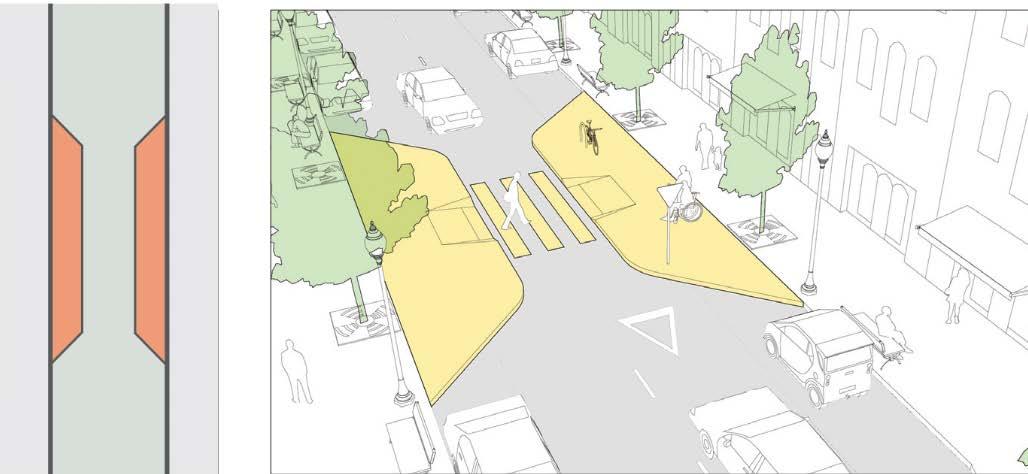

Decreased distance for pedestrians to cross, similar to lane narrowing. Raised crossings at crosswalks deter speeders and decrease chances of accidents. They also provide better access to people living with disabilities and seniors by keeping the crosswalk at the same level as the sidewalk
Fig. 12
Pinchpoints provide safer crossings for pedestrians in the middle of street grids, allowing people to more easily walk directly to destinations rather than go all the way to the nearest crosswalk
Chicanes discourage speeding and create more variety in a street environment, making new space for parking, street trees, and places for residents to sit and socialize
Fig. 14
Added safety for pedestrians and motorists, opportunity for further greenery (trees, shrubs, native plants, etc.)
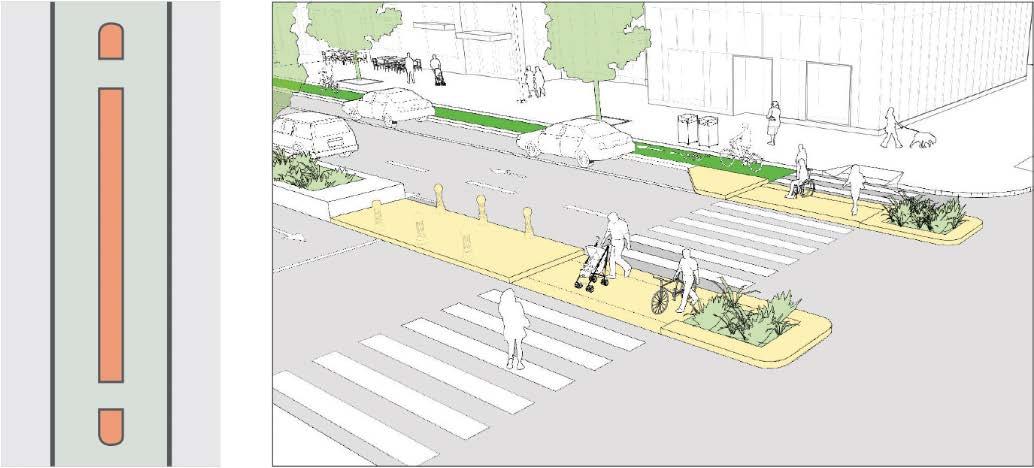
Fig. 15

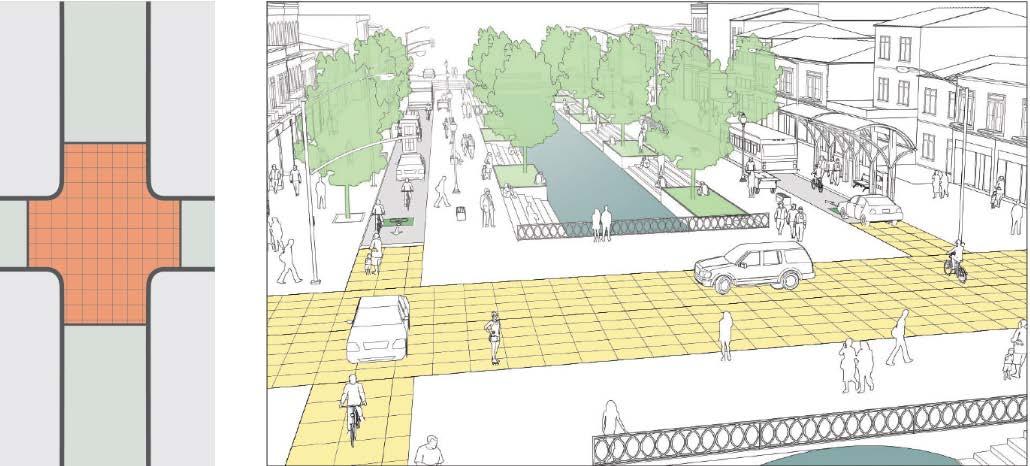
Similar to Beeson and Main St brick treatment, restores historic character to neighborhood and sends the message that the space is not to be treated as a highway, but primarily for slow-moving vehicles and pedestrians

Planting trees at regular and frequent intervals throughout the Historic Downtown is essential for bolstering the beauty of local streets and businesses, cost savings on repaving (since shade from trees protects streets from overheating and cracking), and encourages foot traffic which will benefit area businesses through a more pleasant walking atmosphere
Converting streets to one way instead of two-way allows for several benefits, including expanded on-street parking opportunities, fewer conflict points between cars, decreased chances of accidents, and opportunities to convert unused lanes for other uses. For example, converting the streets surrounding downtown (Penn, Gallatin, Fayette, and Morgantown) to one way streets, one could unlock new possibilities for the public space: Morgantown (3 lanes), Penn (3 lanes), Gallatin (3 lanes), Fayette (4 lanes).

Currently, traffic volumes in and around Uniontown are much lower than they were in the past, meaning that there is excess capacity that cars are not using. This excess capacity can be translated into an opportunity for expanded pedestrian access, bike lanes, and new onstreet parking for residents and customers of local businesses.
Introduction of dedicated bike lanes would also fulfill a key goal of Uniontown leadership and residents; provide safer space and options for residents to bike to work, school and shop. This will decrease the number of cars on the road, which will improve traffic flows and parking opportunities for those residents that still prefer to use an automobile primarily in Downtown. Overtime, increased bicycling capacity will encourage greater biking storage capability, which will allow more people to be in the Downtown than before (for reference, a single car parking space can accommodate up to 12 bikes comfortably!). Adding capacity for people to visit, work, and shop in the Downtown will translate to increased foot traffic for local businesses and encourage organic business expansion as Downtown becomes more of a destination and an even more place to spend time for residents.
1 travel lane in either direction
One turning lane
Narrow sidewalks
No street trees
Limited buffers or planters to protect pedestrians from rushing traffic

Street trees on either side of street, protecting pedestrians from traffic
New parking lane which will facilitate local business and slow down traffic
One travel lane, which increases traffic flow and decreases chance of accidents
One-way bike-lane for commuters, school children, and visitors to Downtown
Fig. 19
Fayette Street (US-40)
Current Configuration:
4 lanes, 1-way, high capacity and underutilized No street trees or greenery
Wider sidewalks than other parts of Uniontown
Fig. 20


Street trees planted on either side, as well as in median
Expanded sidewalks
2-way bicycle track
New on-street parking
One travel lane, 1-way
Fig. 21
For further reading and ideas on street design and implementation, please check out the Urban Street Design Guide.[5]
Distribute planters on corners of streets to create informal curb extensions and shortened sidewalks that make crossings safer for pedestrians and slow down traffic
Narrow streets with bollards or cones to pilot traffic-calming measures
Pilot programs on bike lanes for school children and commuter corridors
Integrate Complete Streets policies with repaving projects to ensure that intersections and streets have the most up-to-date traffic-calming measures possible
Experiment with temporary street closures or converting parking spaces to “flex spaces”, allowing local businesses the option to use them as car parking or extensions of restaurant seating or other uses
Expand Complete Streets policies to entirety of Uniontown to make streets safer and allow more residents the option to safely walk or cycle to and from their destinations
Create comprehensive, safe, and separated bike network that will shift trips from cars to bicycles, thereby increasing public health and decreasing harmful pollution
Coordinate with adjacent townships to unify street design practices, ensuring that surrounding metro residents can take advantage of bike network, expanded business opportunities in Downtown, and increased green space
Investigate the possibility of designating a future “village green”, which would serve as a community focal point. Prime candidates are parking lots that are underutilized or the center parking garage which is nearing the end of its useful life (i.e., will require major repairs to continue to be utilized otherwise)
Fig. 22
Blue - Existing commercial buildings, housing, cultural sites, and municipal buildings
Pink/Red - Targets for renovation and new, trail oriented construction
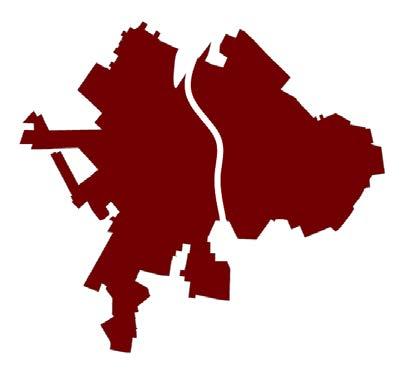
Green - Existing and possible green space sites, including a possible future village green where the current parking structure sits (14 W South st)
Teal - Proposed bike network that will not only connect to the trail and encourage visitors to explore around Uniontown, but also allow residents to connect seamlessly between their homes, workplaces and other destinations
Black - Remaining parking lots, which, even in the future, provide excess capacity for projected amount of future residents, commuters, and residents
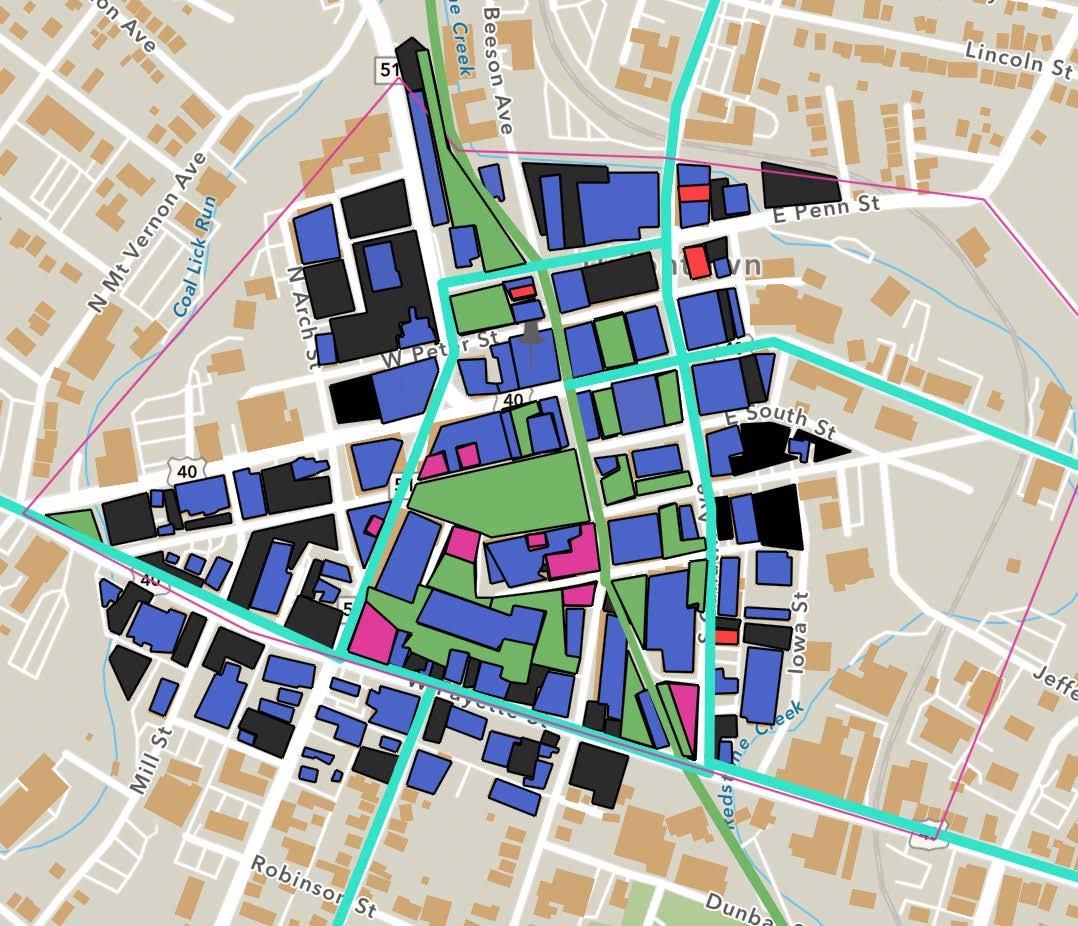 Possible Future Aerial View of Uniontown
Possible Future Aerial View of Uniontown
Fig. 23
Further, zoomed out view. On-street bike networks can connect further north and begin feeding into the trail at key points. In the future, Uniontown could leverage the Sheepskin trail and its bike network to collaborate with neighboring townships to increase the scope of the overall bike network for residents, further decreasing car dependency and encouraging healthy modes of travel for more of the population.

Each of these examples follows principles laid out in the previous pages, namely setting aside deliberate space for allowing people to gather, socialize, engage with their environment, and ultimately build much more community and wealth than excess parking lots or car storage ever can for a particular idea. These images offer inspiration for how Uniontown could leverage its significant land assets and build more meaningful places for people to enjoy the vibrant historical and architectural beauty present throughout the downtown area!
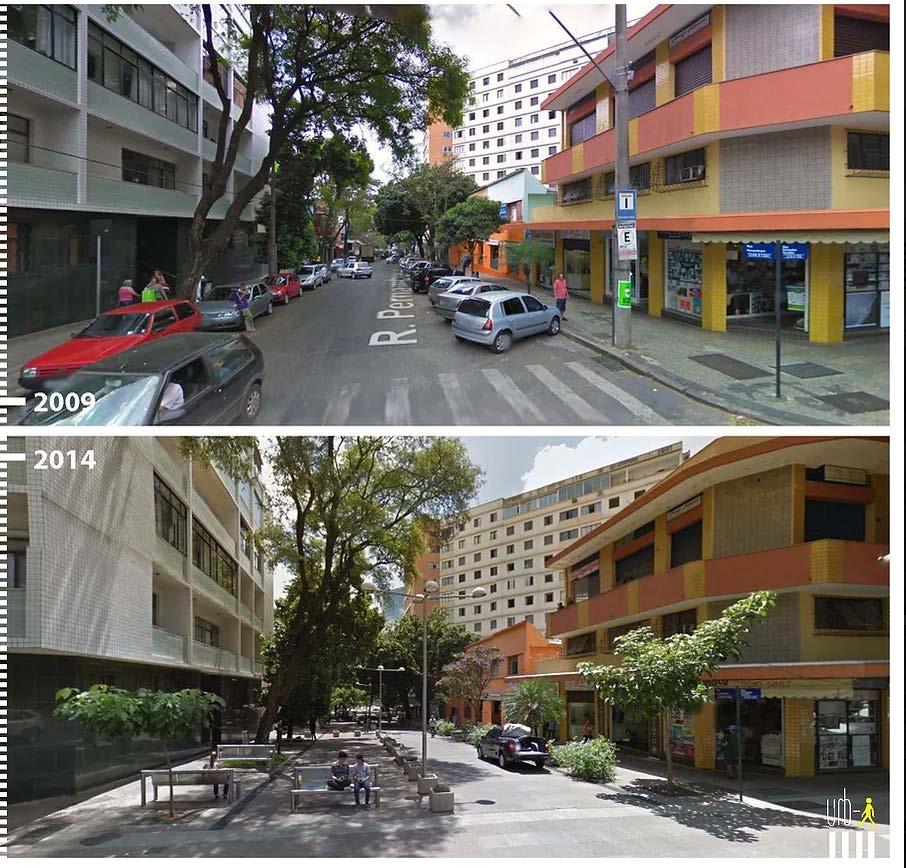
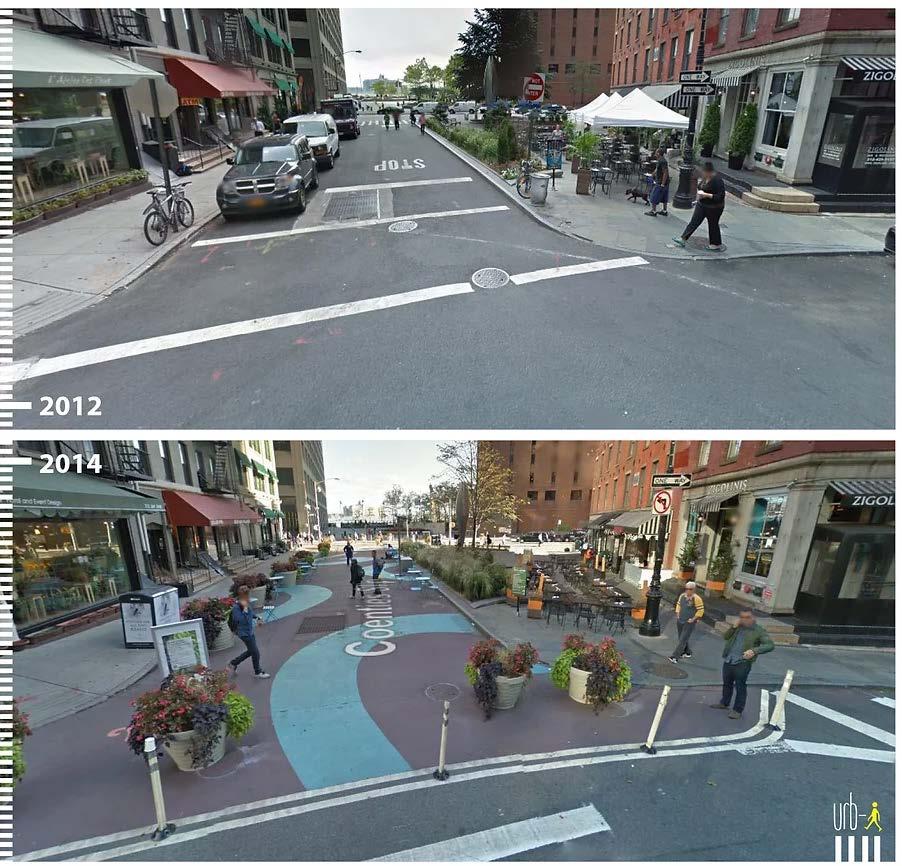 Fig 24. Belo Horizonte, Brazil
Fig 24. Belo Horizonte, Brazil
Funding provided since

by target
grants to causes similar to
Our team gathered a number of government funding sources for consideration by Uniontown officials. Many of these sources have overlap with current funding streams and possible recommendations from outside agencies (such as Fayette County’s Economic Development Department).
There are a number of useful searchable databases that allow anyone to search based on category, requirement, eligibility, and so forth. The flexibility of these online resources aids in focusing and targeting the search for the correct type of funding going forward that Uniontown might wish to pursue in the future. These funding sources are compiled based on category, such as tourism, economic development/revitalization, and transportation. Please see the attached Excel spreadsheet, which details these resources in greater detail.
From our inventory process, we were able to identify trail-based development funding sources for Uniontown from the Pennsylvania Department of Community & Economic Development (DCED), Department of Conservation & Natural Resources (DCNR), and Department of Transportation (PennDOT).
Below we have included information directly from each of the aforementioned departments for grant programs best-fit for Uniontown’s goals.
Included in the Appendix is language from additional funding programs suited for Uniontown’s needs.
Overview: MTF grants are utilized for economic development and ensuring a safe and reliable transportation system is accessible for area users.
Uses: Transportation asset development, rehabilitation and enhancement for existing communities. Includes streetscape, lighting, sidewalk improvements, pedestrian safety, connectivity and transit-oriented development.
Eligibility: Municipalities; Councils of Governments; Businesses; Economic Development Organizations; Public Transportation Agencies; Ports-Rail/Freight Funding: Grants are available for projects of $100,000-$3,000,000.[6]
Overview: The KCP helps the creation of public-private partnerships that support local economic development initiatives; social and economic diversity; as well as enhancements in quality of life. The KCP can be flexible to fit the needs of specific community efforts.
Uses: Planning activities, façade grant programs, accessible housing programs, and development grants.
Eligibility: Local governments; Redevelopment and/or housing authorities; Nonprofit organizations such as community development corporations and economic development organizations, housing corporations; Business Improvement Districts, Neighborhood Improvement Districts, Downtown Improvement Districts, and other similar organizations
Funding: Grant funding up to $500,000[6]
Department of Conservation & Natural Resources (DCNR)
Overview: DCNR's goal is to have a trail within 15 minutes of every Pennsylvania citizen. DCNR's Bureau of Recreation and Conservation provides grants to support the enhancement and expansion of nonmotorized and motorized trails to meet this goal. Trail grants are awarded through the Community Conservation Partnerships Program.
Uses: Uses include trail land acquisition, planning, development, rehabilitation, maintenance, education and equipment purchases.
Eligibility: Varies program to program but includes municipalities, municipal entities and nonprofit partners
Funding Programs: Keystone Recreation, Park and Conservation Fund; Environmental Stewardship Fund; Pennsylvania Recreational Trails Program[7]
Overview: Community Parks and Recreation grants from the DCNR’s Bureau of Recreation and Conservation works to build connections between citizens and the outdoors. Through this program DCRN funds technical assistance for recreation and park improvement projects through the
Community Conservation Partnerships Program. Priority is given to projects that help advance Pennsylvania’s 2020-2024 Statewide Comprehensive Outdoor Recreation Plan.
Uses: Funding is available to assists communities with planning for public parks, recreation, conservation areas, and facilities. Funding also is available to assist communities with the rehabilitation and development of sustainable public parks, recreation and conservation areas, and facilities.
Eligibility: Municipalities; Municipal Agencies; Nonprofit Organizations
Funding: Most of the available funding opportunities require a cash or non-cash matching contribution that is equal to 50 percent of the project cost.[7]
Overview:The TASA provides funding for transportation alternatives projects. The TASA is not a grant program. Projects directly supported include on and off-road pedestrian and cycling facilities, infrastructure, access to public transportation, mobility enhancements, community improvements, environmental mitigation, trails that serve as transportation routes, and safe school routes.
Uses: Cycling and pedestrian facility development and improvement; K-8 cycling and pedestrian education; railway to trail conversations; construction of turnouts, overlooks, and viewing areas; historic preservation and rehab; vegetation management; vulnerable road user safety assessments; storm water management; and wildlife preservation.
Eligibility: Localgovernments;regional transportationauthorities;transitagencies; naturalresourceorpubliclandagencies, includingFederalagencies;schooldistricts, localeducationagencies,orschools;tribal governments;anMPOthatrepresentsan areawithapopulationof200,000orfewer; anynonprofitentity;astate,attherequest ofanothereligibleentity;anyotherlocalor regionalgovernmentalentitywith responsibilityforoversightoftransportation orrecreationaltrails(otherthana metropolitanplanningorganizationoraState agency)thattheStatedeterminestobe eligible,consistentwiththegoalsof subsection(c)ofsection213oftitle23.
Funding: ThoughtheTASAisnotagrant, projectsarefundedat100%ofthe constructioncost.Nomatchingfundsare required.Sponsorsmustpayforproject design,pre-constructionpermits,and clearances.Projectfundingrangesfrom $50,000-$1,000,000.[8]

Afteracarefulreviewofall85foundations’990-PFForms,ourteamwasabletoreducethe foundationpoolto65.Thetwenty,excludedfoundationswereremovedforoneofseveral reasons.SomefoundationswerecompletelyinapplicabletoUniontownanditstrail developmentwork,likefoundationsfocusedonEconomicDevelopmentofBuffalo,New York.Otherfoundationswerecutbecausetheformatoftheirgivingwasnotco mpatiblewith Uniontown.Forinstance,onefoundationisstructuredasacrowdfundingplatformandonly hasForm990-PFsasalegaltechnicality.TheNonprofitResourceCentercoversabroad swathoffoundations,soweexpectedsomemeasureofcuts.
Theremaining65foundationswerefurthersplitintothreecategoriesbasedonpriorityof application:Target,Mid,andLow.EachcategoryisgivenonepagewithinthePhilanthropic FundingSources.xlsxExcelnotebookth atwehaveattached.Eachcategoryhasaround20 foundationsandsummarizesthefindingsofeachfoundation’s990-PFforms.Notallgrants fromthe990-PFsareincluded,specificallyourteamonlyincludedgrantsthatwefeel Uniontowncouldqualifyfor.Throughamanualreviewofeachfoundation'sforms,we annotatedhowoftenspecificfoundationsgivegrants,howmuchthosegrantsarefor,and whatcategorythegrantappliesto.Theendresultofthisanalysisisasingl erowforeach foundation.Theformatoneachofthethreecategorypagesisidenticalandincludes:

Foundation name: As found on the Form 990-PF.
A notes field: A brief description of the foundation and their donation practices. Total amount for all donations: All grants given by total dollar amount
Number of grants given: A count of all grants given by category (Bike and Pedestrian Development, Urban Redevelopment, Sustainable Development, Tourism, Exercise)
A grant writer may read an example as follows: Staunton Farm Foundation has made three Urban Renewal and six Tourism grants for a total of $169,000 from 2018-2021. This foundation focuses on local, cultural organizations and community-oriented donations.
Foundations are split into priority categories along several criteria including likelihood of a Uniontown donation, total grant amount, and total grant count. The foundation’s focus played an outsized role in placing foundations in the Target category. For instance, Allegheny Foundation has a very significant focus on Southwestern PA and historical initiatives. Foundations in the Mid category lacked a direct focus on Uniontown and trail development activities, but are likely worth applying to. Around half of these foundations have considerable donation ability and a general foundation focus and the other half have a very specific foundation focus with small donation ability. The final category, Low, is almost entirely composed of massive corporate foundations, like PNC, Highmark, and Fidelity. Donations made by these foundations are extremely varied and numerous. Uniontown grant handlers will notice that the Notes and Grant summation sections are relatively sparse for the Low foundations; this is intentional.
These foundations are very general in their giving and difficult to classify. Although we recommend that Uniontown pursue these foundations for grants, we rate them as low priority due to their unpredictability. All foundations can be reviewed in the attached Excel spreadsheet, Philanthropic Funding Sources.xlsx. Additionally, we have included a brief video that reviews how to use the Funding Sources tool at the following link:
The incredible variance in the private foundations necessitates two recommendations. First, our team recommends using the proposed Office of City Manager/Administrator to help facilitate the grant making process. During our review of the benchmark trail cities, we encountered many local governments that employed a Development Officer within the Office of City Manager/Administrator. This city function represents a critical funding stream for trail development and other future city projects.
Uniontown will need to manage many relationships with private foundations and juggle the grant making process for each. These activities are best handled by individual(s) with long-term, institutional knowledge.
Our review of all 85 private foundations is a summary, not an exhaustive explanation of each foundation. To acquire long term funding from these private foundations, Uniontown will need to build trust with each organization.
Second, we recommend utilizing the proposed Office of City Manager/Administrator as a public service for all Uniontown organizations and residents. In our experience, private foundations are willing to distribute grants to a wide range of organizations. Having letters of support and administrative backing from the City helps increase the chances of nonprofit partners successfully raising grant funds.
One of the most common grant targets we recorded was for local theaters, like Uniontown’s State Theatre. Uniontown should aim to support their private organizations with as much external grant funding as possible. Fortunately, Uniontown’s Office of City Manager/Administrator will be uniquely qualified to recommend foundations, handle the grant making process, or direct organizations in the process.
The key to developing long term, sustainable funding streams is building trust and relationships with regional funders. Building that trust and relationships however takes time, effort, and persistence. Funding for big ideas often start small, but with success comes greater access to funding. In our research, we have found a framework that leads to a higher likelihood of success.[9]
The first step towards writing any successful grant is a collaborative visioning and budgeting phase. Here you will identify key partners, collaboratively design a vision of what a successful outcome of the project looks like, and define each others’ roles. Building strong partnerships is a key aspect of successful vision development. Identifying partners with areas of expertise that can add to your vision will make for a stronger grant proposal.
Additionally, a preliminary budget should be collaboratively designed, including programming/project costs as well as staff and administrative costs.
A letter of inquiry (LOI) is the first step in engaging a funder. A good LOI that speaks to the funder’s priorities will lead to an invitation to submit a full proposal. LOIs often serve as the first introduction a funder has to your organization, and therefore should include information on your organizational mission. The LOI should also describe your project, the need your project will serve, the method by which your project will serve that need as well as other funding sources you will be leveraging. A sample LOI is provided within the Appendix.
A good time to start drafting your proposal is after your LOI has been sent. Funders will likely request a meeting if an LOI raises their interest. Having a well articulated first draft of the proposal will help build a strong pitch to a funder and help the funder better understand the proposal. The draft proposal should include the preliminary budget and support the proposal. A funder in this instance will provide direct feedback on what will make the proposal a right fit for them. This may indicate willingness to funding the initiative in full, or partially to start.

Asuccessfulmeetingwithafunderwillleadtoarequestforafullproposal.Afullproposal shouldincludeindetailthemissionandvisionoftheinitiativeandallofthefunder’s recommendations.
Afullbudgetshouldbebrokendownintospecificlineitems,includingmaterialscosts, expectedstaffcosts,expectedadministrative/overheadcosts,andanyotherexpected costs.Eachlineitemshouldbeconnectedtospecificprogram/projectactivitiesthatare furtherdefinedinthefullproposal.
Afullproposalshouldalsodiveintodetailaboutyourexpectedmeasuresofsuccessand finaloutcomes.Specificmetricsshouldbeselectedtomeasureyoursuccess,andaplan shouldbearticulatedonhowthosemetricswillbetrackedovertime.Mostfunderswillaskto providedatadriveninsightsintotheinitiative’soutcomesandcomparethemtoyour expectedoutcomes.Successfulimplementationof yourprogramswillincreasethelevelof investmentfundersarewillingtomakeforfuturefundingrequests.
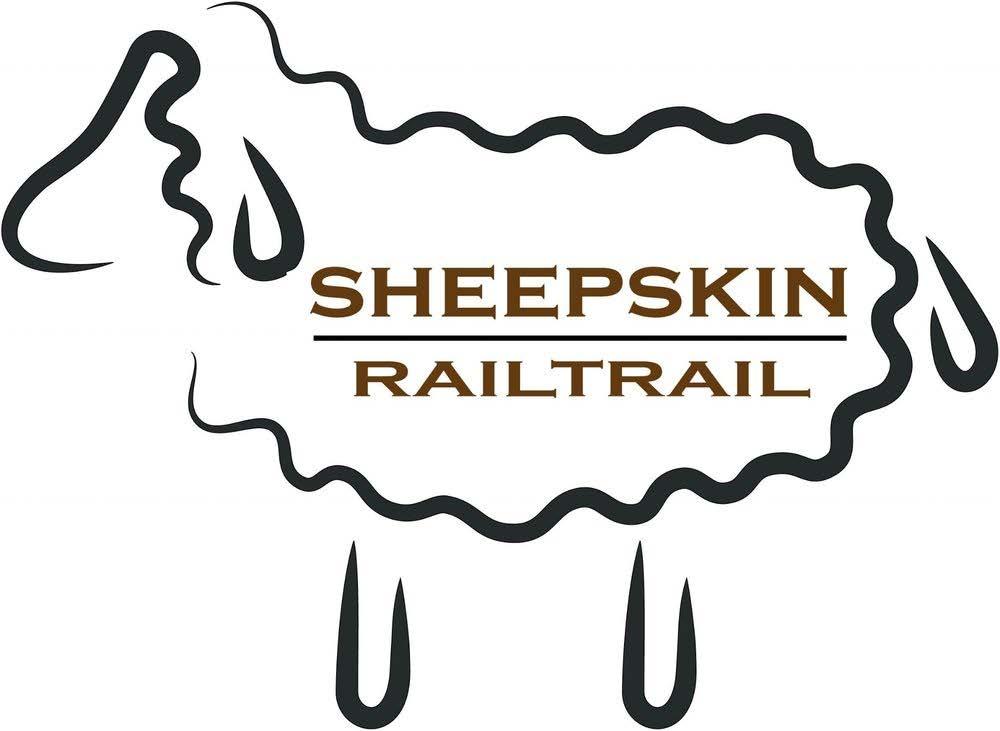
This application links to the The Governor’s Center for Local Government Services (GCLGS), which provides technical assistance to municipalities for fundamental and short term projects. This is the first step for Uniontown to explore the creation of an Office of the City Manager.


Sample Letter of Inquiry from Cleveland Entrepreneurial Preparatory School to Burton D Morgan Foundation. Courtesy of Candid.[12]
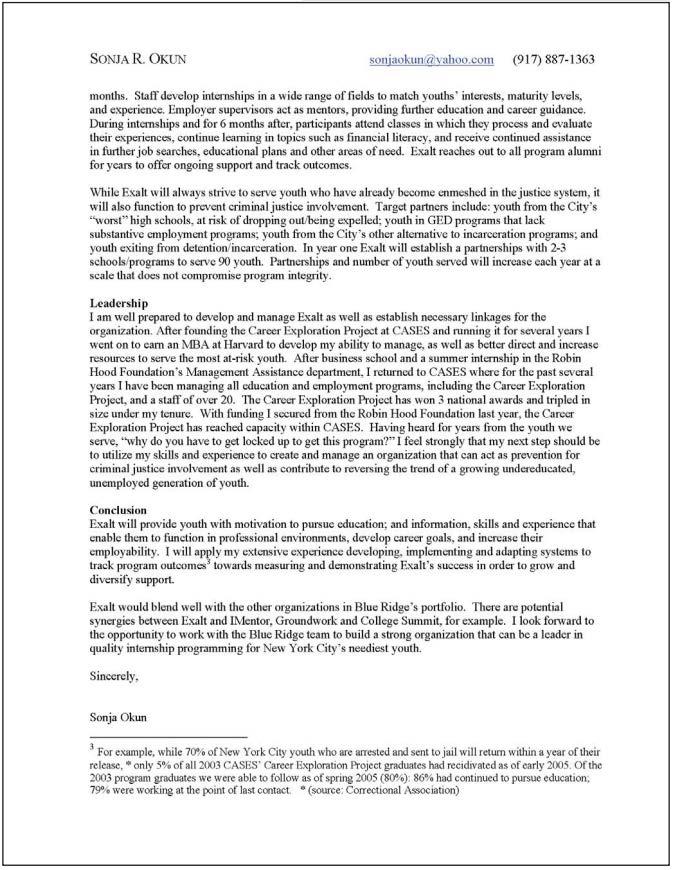
A RESOLUTION OF THE MILLVALE BOROUGH COUNCIL, ALLEGHENY COUNTY, PENNSYLVANIA, ADOPTING A COMPLETE STREETS RESOLUTION TO BETTER INTEGRATE PHYSICAL ACTIVITY INTO THE DAILY LIVES OF THOSE WHO LIVE IN AND VISIT THE BOROUGH OF MILLVALE THROUGH AN INCREASED EMPHASIS ON VARIOUS ACTIVE TRANSPORTATION MODES WHICH WILL ULTIMATELY CONTRIBUTE TO IMPROVED HEALTH, REDUCED TRAFFIC CONGESTION, IMPROVED AIR QUALITY, A REDUCTION OF HARMFUL ENVIRONMENTAL IMPACTS, AND THE CREATION OF AN ECONOMICALLY VIBRANT AND SUSTAINABLE PROGRESSIVE COMMUNITY.
WHEREAS, it is the intent of the Borough of Millvale to provide safe and convenient streets for users of all ages and abilities, including pedestrians, bicyclists, public transportation riders, and motor vehicle drivers; and
WHEREAS the Borough of Millvale recognizes that streets are a key factor in the way people experience the public realm and play a vital role in promoting economic development, public safety, health, recreation, community, connectivity, and quality of life; and
WHEREAS, the Complete Streets resolution can be used to guide transportation improvements on streets within the Borough of Millvale; and
WHEREAS, the design and function of streets shall consider the needs and safety of all users of the transportation network, particularly pedestrians, bicyclists, public transit users, persons with accessibility needs, as well as motorists and freight drivers; and
WHEREAS, the Borough of Millvale, is a community in which many residents rely on public transit, walking, and cycling to get to; work, shop, health care, and family; and WHEREAS, investments in pedestrian, bicycling, and transit infrastructure will help promote active transportation and expand the accessibility of regular physical activity for the citizens of the Borough of Millvale, which will improve their health, reduce the incidence of conditions related to inactivity, improve air quality, and limit or reduce negative impacts on the environment from traffic; and
WHEREAS, the Borough of Millvale seeks to create an interconnected network of transportation facilities that accommodate all modes of travel in a manner consistent with the community context and goals and that incorporate green infrastructure measures where appropriate; and WHEREAS, transportation improvements should plan and design in a manner consistent with, and supportive of, the surrounding community, recognizing that all streets are different and that the needs of various users will need to be balanced in a flexible manner; and
WHEREAS, the Borough Council of the Borough of Millvale, Allegheny County, Pennsylvania shall at their discretion seek input from residents or non-residents with specific knowledge or experience regarding Complete Streets and or transportation for review or implementation of Complete Streets projects; and
WHEREAS, the Borough of Millvale is committed to providing increased mobility choices and improved safety for all residents and visitors, as embodied in the goals and policies of the Borough of Millvale’s Multi-Municipal Joint Comprehensive Plan, formally adopted with the Boroughs of Etna and Sharpsburg in 2014, and further supported by the goals of the Live Well Allegheny Program.
NOW THEREFORE BE IT RESOLVED, that the Borough Council of the Borough of Millvale, Allegheny County, Pennsylvania, commits to the Complete Streets Resolution that will incorporate Complete Streets into the planning, design, and operation of future municipal streets, sidewalks, trails, pedestrian and bicycle pathways, and other transportation projects, and will include Complete Streets intent when updating the Millvale Borough Code of Ordinances as defined in Sections 1, 2 and 3.
Section 1. All roadway projects, including construction, re-construction, re-paving and rehabilitation, will provide appropriate accommodation for pedestrians, bicyclists, transit riders and drivers, motorists and freight drivers, and people of all ages and abilities, including children, older adults and persons with accessibility needs, except under one or more of the following conditions:
• The cost would be excessively disproportionate to the need or probable future use over the long term,
• There is an absence of current and future need,
• The roadway project is comprised of ordinary maintenance activities designed to keep assets in serviceable condition (e.g., mowing, cleaning, sweeping, spot repair and surface treatments such as chip seal),
• Where use by non-motorized users is prohibited by law.
Section 2. Appropriate accommodations include facilities and amenities that are recognized as contributing to complete streets, which may include sidewalks and pedestrian safety improvements such as:
median refuges; pedestrian signals; bulbouts and crosswalks; street and sidewalk lighting; improvements that provide ADA (Americans with Disabilities Act) compliant accessibility; transit accommodations including improved pedestrian access to transit stops and bus shelters; bicycle accommodations including shared-use lanes, wide travel lanes or bike lanes as appropriate; paved shoulders; bicycle parking; street trees; street design; street furniture; drainage facilities and storm water facilities; And other facilities deemed appropriate by the Borough Council of the Borough of Millvale, Allegheny County, Pennsylvania.
Section 3. Complete streets principles will be incorporated into the comprehensive plan, subdivision and land development ordinance, and other plans, manuals, regulations and programs as directed the Borough Council of the Borough of Millvale, Allegheny County, Pennsylvania,.
ADOPTED this 14th day of August 2018 by the Millvale Borough Council in meeting assembled.

At the start of this project, the advisory board shared that Uniontown is experiencing a shift in politics away from an older generation and towards 30-40 year old residents. This trend is further reinforced by Census Bureau and American Community Survey data for Uniontown, as we see two age peaks that match our community survey and the anecdotes.[10]
Despite these warnings from the advisory board, we are surprised to see how much our survey over captured the 35-44 year old demographic. Comparing the community survey to Facebook usership data helps to explain this peak as Facebook users are predominantly 1854 years old.[11] We feel this is an example of our self-selection bias, given that most of our respondents found us through Facebook pages. In contrast, our survey most likely outpaced the 57-72 year old demographic because of our focus on the Sheepskin Trail and Uniontown residency.
Overwhelmingly, our respondents are residents of Uniontown (~60%), followed by visitors (~20%), employees working in Uniontown (~17%), and business owners (7%). Respondents were allowed to select multiple options, e.g. Resident and Business Owner. Given that the Sheepskin trail will run through Uniontown, we are very pleased with the resident response rate. Because our survey was distributed in mostly Uniontown related forums, our survey results do not represent non-Uniontown citizens as well. Our team considered ways to solve this problem, but ultimately it is difficult to survey a population that is unaffiliated with an organization, e.g. tourists visiting from out of state for a weekend. We recommend follow-up surveys after the Sheepskin Trail is completed to survey tourists and travelers; these could be administered with the cooperation of small businesses or along the trail itself.
Overview: Act 13 of 2012 establishes the Marcellus Legacy Fund and allocates funds to the Commonwealth Financing Authority (the “Authority”) for planning, acquisition, development, rehabilitation and repair of greenways, recreational trails, open space, parks and beautification projects using the Greenways, Trails and Recreation Program (GTRP).
Uses: Projects which involve development, rehabilitation and improvements to public parks, recreation areas, greenways, trails and river conservation.
Eligibility: For-Profit Businesses, Municipalities, Councils of Governments, Authorized Organization, Institution of Higher Education, Watershed Organization
Funding: Grants shall not exceed $250,000 for any project. A 15% match of the total project cost is required.[6]
Overview: The Historic Preservation Tax Credit (HPTC) provides tax credits to qualified taxpayers who will be completing the restoration of a qualified historic structure into anincome producing property. All projects must include a qualified rehabilitation plan that is approved by the Pennsylvania Historical and Museum Commission (PHMC) as being consistent with the standards for rehabilitation of historic buildings as adopted by the United States Secretary of the Interior.
Uses: Tax credits may be applied against the tax liability of a qualified taxpayer which includes an individual, corporation, business trust, limited liability company, limited liability partnership or any other form of legal business entity. The tax credits awarded to a qualified taxpayer shall not exceed 25 percent of the qualified expenditures as determined by the application in connection with the completed project. Tax credit awards can be increased to 30 percent of the qualified expenditures in connection with a workforce housing completed project. The total tax credits awarded to a qualified taxpayer may not exceed $500,000 in any fiscal year.
Eligibility: Those eligible to apply are qualified taxpayers which include an individual, corporation, business trust, limited liability company, limited liability partnership or any other form of legal business entity. Qualified taxpayers must be subject to the Personal Income Tax, Corporate Net Income Tax, Capital Stock-Franchise Tax, Bank and Trust Company Shares Tax, Title Insurance Companies Shares Tax, Insurance Premiums Tax, Gross Receipts Tax, or Mutual Thrift Institutions Tax.
Funding: The commonwealth shall issue no more than $ 5,000,000 in tax credits per fiscal year. Credits will be awarded equitably for projects in each region of the commonwealth.[6]
Overview: The Marketing to Attract Tourists Program provides funding to support and development international tourism, sports marketing, outdoor recreation, and cultural attractions.
Uses: A primary goal of the program is to promote overnight stays. Applicants should, as part of the project narrative, explain how their project will meet this goal.
Eligibility: Non-profit organizations with a significant interest in the development of tourism product that provides a visitor experience to a tourist region, destination and/or attractions are eligible to apply. Funds may be used to: Support events; Fund facility enhancements; Support new construction and/or renovations; Develop marketing, advertising and public relations campaigns to build attendance
Funding: Funding to attract tourists.[6]
Overview: Installment loans, lines of credit and technical assistance for minority business enterprises, women-owned business enterprises and small businesses.
Uses: Cash flow (working capital) – Including most business operation and expansion expenses; Equipment – includes acquisition, delivery, installation, and renovation of new and used equipment; leasehold improvements; and acquisition of owner-occupied real estate. When necessary, the participating community development financial institutions (CDFIs) will provide technical assistance to borrowers in procurement, certification as minority or women contractors, bonding and bid preparation.
Eligibility: Any small business may apply, but the program will give priority to small businesses requiring capital and technical assistance in order to compete for governmental and private sector contracts.
Funding: There are no minimum or maximum loan sizes. Interest rates and other terms and conditions are determined by the participating CDFIs.[6]
Overview: The Partnerships for Regional Economic Performance (PREP) is designed to encourage regional coordination in economic development efforts, yielding superior customer service to the business community and a comprehensive, efficient statewide economic delivery strategy.
Uses: PREP will provide grants to consortia of economic development service providers that may co-locate, develop formal partnership agreements, or otherwise create a coordinated and performance-based service delivery system that ensures each inquiry or lead from a business or potential entrepreneur is referred to, and acted upon expeditiously by, the appropriate service provider(s) in the region.
Eligibility: The PREP program is designed to integrate the delivery system historically served by the following core service providers: Industrial Development Organizations, Local Development Districts (LDDs), Small Business Development Centers (SBDCs)
Funding: $7.38 million available for FY2019-20.[6]
Overview: The goal of the Partnerships Grant Program is to advance collaborative multimunicipal or large-landscape recreation, conservation, and heritage projects. Funding is available for partnerships projects that help build local, county, regional, and statewide capacity to better develop and manage resources through the creation and implementation of public planning processes.
Uses: Convening, education, and training projects foster public engagement in our natural and cultural resources though the provision of forums, training, and education programs. Example projects include: Educational conferences; Workshops; Publication development; Public forums; Other direct engagements
Eligibility: Single municipalities intending to establish multi-municipal partnerships; Statewide and regional nonprofit recreation, conservation, and greenways organizations; Regional municipal entities; Pennsylvania’s 12 state-designated Heritage Areas.[7]
Overview: DCNR helps communities and nonprofit organizations across Pennsylvania acquire land for public parks and open space to be enjoyed by all for generations to come. Many of these projects are administered by DCNR’s Bureau of Recreation and Conservation.
Uses: The acquisition of lands that are added to state parks, state forests, and state gamelands; Grant funding assistance for acquisition of trail corridors, recreation areas, greenways, critical habitat, and other open space by local government or nonprofit organizations; Grant funding assistance for the purchase of conservation easements; Grant funding assistance to organizations for large, landscape-scale planning efforts.[7]
Overview: Act 89 of 2013 created a new deputate for multimodal transportation at PennDOT. This organization is comprised of local and public transportation, rail, freight, ports, waterways, bicycle and pedestrian, and aviation, and focuses on efficiency, capital investments, safety, and mobility in these modes.
Uses: This organization is responsible for programs in the following areas: Local and Public Transportation; Rail freight; Ports and waterways; Aviation and airports; Bicycle; Pedestrian.[8]
Question 1: Many communities are finding success cultivating a competitive advantage by using their unique assets to attract new investment and support existing businesses. What assets has your community used to emphasize building on these existing community assets?
Along the GAP: the key assets for any of these towns have included overnight lodging starting with bed and breakfasts. A hotel is fine; the hotels in Cumberland and Connellsville do fine but its mostly B&B, Inns and Guest houses that attract the middle and upper middleclass retirees with money. They will go out of their way to have an “interesting and lovely” place to stay.
Two B&Bs to choose from because competition is good; would be great for Uniontown. Opportunities here for entrepreneurs. This would be worth cultivating.
On top of the B&B world – you need a restaurant and a place to get lunch that is bikefriendly and full service and relatively quick. People burn a lot of calories on their biking trip. The first thing you want to do when you arrive is find a good place for a sandwich, wrap or drink. A friendly place with music or live entertainment and a physically interesting place. Create a “good vibe” – whether its interesting menu items, good music, chalkboard display on the front.
You need to cover an overnight guest with lunch, dinner
Something interesting to go see. Highlight something that is unique or interesting. Could be an interesting green space. A place to people – watch, a place to hang out for a little while. Place for outdoor music or live theatre. A festival you might want to plan your trip around.
There is a festival in Meyersdale called the Pennsylvania Maple Festival and it draws quite a crowd from all over! There’s a parade, pancake eating contest, crowning of a maple queen! Confluence has a Pumpkin Festival: it’s a fall festival, with leaves and apples – its quaint and interesting. Need a reason to go into town. Uniontown needs a place like a passive public green space patio or plaza or an event or series of events that could draw people in on Fri, Sat, Sun; those are the busiest.
A similar draw might be public art. There are murals – a local mural tour, a sculpture garden, a fountain, or a series of fountains, a historical tour that I can take. Beauty? Even if its reclaimed industrial heritage beauty that Uniontown could market. A reason to ride off the GAP or sheepskin trail.
I- Two other small suggestions: is there a bike shop in town? Is there a place if my brakes need to be adjusted and need to buy a piece of gear or when my medal has to be adjusted? A coffee in the morning and an ice-cream in the evening: early and late where I can just hang out; this is on top of the restaurant and on top of the B&B. The kind of vibe walnut street has versus Homewood, south side, slopes where there isn’t a reason to go.
Any amenities in town needs to serve the residents first; the trail business is seasonal and there needs to be a cash flow model and business plan implemented for them. Truly, the tourists want to go where they see locals enjoying so from a sustainability standpoint –entrepreneurs need to stand the cost. Can they do it for 12 months? Or 9 months? Expectations on the type of business that has been built.
Public art and green space has to fit in with a master plan for the city. Needs to be desired and wanted by locals. Not building stuff for tourists.
Playground and safe places for families to be down in the city
Adequate parking
Big theatre is a big asset for stage performances and live music.
Take a look the concept of ‘Nature-based place making’ try to help local folks in Connellsville to see their town more attached to and gateway to the natural places that surround it. What if Uniontown became the deployment place for tourists before going in the Laurel Highlands? You can position these towns for tourists in that way – local folks need to embrace the outdoor opportunities and exploration.
Vintage bikes that locals had, signs up of “Stop here”, “Stop at this place”.
Question 4: What methodology did you adopt to find the right funding partners for these specific goals?
Appalachian regional commission is a federal agency that oversees and has big funding pots available from Alabama, NY, West Virginia.
Funding from the ARC, department of economic development at the state level, foundation dollars might be harder to come by depending on what the project is, corporate dollars are already spread thing in Uniontown because of lack of major employers in the region.
Dependent on project: rehabbing a warehouse into a cool club/coffee shop? Loans and grants available for keystone, other state or federal designation that Uniontown may fall into. Entrepreneurs there might be the Progress Fund. They are doing a good job for B&B.
If there is a space turn-key ready, one that is ready for occupancy. That is a huge advantage logistically versus a building that needs to have a new roof put on it. But it’s a different kind of investment: this is an advantage to attract businesses
Accessibility to the trail is a great asset: cyclists new to town will be more likely to get off the train and get into business districts if they see right of the trail some signage or flowers or kind of products they are looking for in sight.
You need a hotspot. A small healthy district! Give tourists a sense of place and health.
On a practical level: one other thing that has been good in Meyersdale where there are three B&Bs because it is the right distance from Cumberland and Ohiopyle. The three proprietors will share information one to another – there is a partnership. Collaberative and helpful. In Confluence, local businesses have formed a Tourism Association other than Pittsburgh that has a purposeful group of people, chambers of commerce but no one has a group interested in focusing their efforts on bringing new people into town except for Confluence.
A business improvement district is a legally set aside zone in which businesses must pay an additional tax for common marketing. A street cleaner, kiosk with names and addresses, façade improvement, someone to water the plant. Any of these towns could do the same things. The more conservative the town, the more tax averse they are and perhaps less willing to work together on a common project. But that’s an opportunity to look into!! Could generate up to 10k a year and you can maintain the community.
Wayfinding signage especially from the trail if it is not going right through Union-town. “Welcome to Uniontown”, “You have arrived”, “You are here! Things to Do:”.
If there is a river advocate in town, that would be someone to communicate to. One of the reasons that the gap towns are beloved and the perception is that the water is clean and can be viewed. If there is a public water way in Uniontown it might be an attraction.
Amy and Cathy are great resources and they worked together at an organization called the Progress Fund and together championed the trail town. They helped folks on the great Allegheny passage – consider their business districts and assets to be more trail friendly.
-The sheepskin trail allows them to connect with something that already exists.
- Communities are run by many people and we must get the communities together. - Needs to include multiple people together working with a common vision.
- Show a few successes in each of these towns and people themselves start to show it themselves.
Question 2: Could you give us a brief preview of development of the GAP and how the Progress Fund was involved?
Trail-town program by the progress fund (2006): Small business lender, bicycle shop, distillery,
Four necessary partners: trail builders GAP, the progress fund, Laurel highlands (marketing). Needed money to pay for building the trail and all this.
2001 – identified lack of rider services
2005 – formed trail town concepts
2006 – the progress fund raised 2m 2007 – hired trail town program staff 2009 – expanded program to Maryland 2012 – real estate development initiative
2016 – shifted to information sharing 2018 – published trail town guide 2.0 2021 - GAP economic impact report
The progress fund gives business loans: Airbnb, hostels, breweries, restaurants, bike racks and fix-it stations, Trailhead and park improvements
- 63% of businesses offer goods/services to GAP in 2019.
- The businesses need to realize that almost anybody in Uniontown can serve these tourists - Drugstores, gas stations, bike shops, ATM. They need everything!! Almost everybody is involved.
The trail town program:
For Union town to be about to be connected to GAP and not find a way for people to come in for economic development, real state value. Help the public make money.
Most people want to eat, get out of the rain, spend night in hotel, need bike shops
Takeaway or sit-down restaurants
Piece of clothing or bicycle seat hurts too much
People like entertainment! (Dinner, music, festivals, museums, people watching, park).
If those things are offered – the distance people ride is shorter. Once there were more services, average rides were down to 25 miles from 40 miles.
Question 4: What methodology did you adopt to find the right funding partners for these specific goals?
Small businesses have to have their own money. Personal wealth
The progress fund (CDFI)
Bridgeway capital (CDFI) has an office in Uniontown
Banks, net worth and collateral can come into play
Foundations:
Building public improvements
Trailheads
DECD
They will give it to the jurisdiction
Promises were made to Connellsville; we will build it and people will show up. Its advantage is that it could connect to an existing trail. How do we get people off the gap into our town to stay! They need to have a draw to get into Uniontown
Uniontown has to figure out its place on the trail!! How will they market it and differentiate it. How will they draw people off the GAP into the town?
Question 1: Have you engaged with the Uniontown and Sheepskin Trail teams? If yes, what has your history of collaboration looked like?
Working now on developing Comprehensive Plan for Uniontown
Has previously worked with Mon River Towns program. Is a for-profit but worked with nonprofits because they can access a diverse set of funds. Cathy’s nonprofit partner became the National Road Heritage Corridor —
Has worked with Donna to assist with Sheepskin Trail. Has worked with Donna for many years and she is well versed in trail building. Sheepskin will connect with GAP at Point Marion, which is on the Mon. Uniontown has been front and center – has worked through Donna on Sheepskin Trail for several years.
NRHC will continue to engage with Uniontown in the long run. Offices are in Uniontown on Main Street.
Question 2: What do you think are tangible opportunities for Uniontown to chip away at in the next 5 years?
Trails are an amazing economic generator. The longer the trail, the greater the benefits. The more the Sheepskin connects, the more Uniontown will benefit.
Trail has the opportunity to attract a much larger market. Multiple millions in opportunity for communities connected to long trails. Services and other kinds of businesses needed to support rail can help. Uniontown is well positioned for those businesses. Lots of historic buildings in Downtown Uniontown.
Has been less positive for Uniontown because the population base isn’t huge. Tourism brings in a population base. Trails are one piece of a larger puzzle, but a significant one that Uniontown can build on.
Question 3: From your perspective, what are Uniontown’s greatest opportunities with regard to economic development around the Sheepskin trail?
Gist: Investing in Sheepskin Trail and other historic assets downtown. DCNR publishes multiple studies showing economic benefits of trails. There are multi-season tourism opportunities all around the Laurel Highlands, and connected by Rt 43 to large urban areas.Turnpike, Rt 40, etc.
Uniontown has all major pieces for economic growth.Can they come together to pull in the good while addressing the challenges that need to be addressed?
Question 4: How would we best connect Uniontown to the recreation that exists in the area? How do we get word out about Uniontown?
Laurel Highlands Visitors Bureau – if Uniontown isn’t already working with them, they need to. They are the visitor attractor.
Uniontown can do a lot more with effective signage. A lot more marketing alongside LHVB as well as others.
Marketing opportunities that say “Come to Uniontown” Ohiopyle was able to rapidly pivot. Uniontown hasn’t been able to do that. Why not come to Uniontown, stay in Uniontown. You can do it all. Shop, stay, but also easy access to regional amenities. A ton of historic resources along the way.
Question 5: From your perspective, what are Uniontown’s greatest challenges with regard to the economic development around the Sheepskin trail?
Specific to the Sheepskin – always always always funding.
Lacks funding, population base, and depth of business community
Entire region has to look at other sources for attracting businesses and population. Won’t have large influx of young people all of a sudden.
Jobs are changing and you can work from afar, and maybe in the future there will be opportunity for growth, but right now need to look at more near term opportunities.
Question 6: What are primary funding mechanisms used by trailtown communities in Western PA?
They definitely have to go for DCNR. That is the single largest funder of trails in the commonwealth. DCNR is enthusiastic about trails. They also need a match many times. Philanthropic funds can be hard to come by. Has become hard to come by. Benedum has refocused on education in WV. Philanthropic opportunities exist. RK Mellon.
Philanthropic can be a nice match, but there are also federal funds. PennDOT will do some trail building. There are some community based tourism grants, but that’s more focused in Washington County. Cathy has only began to scratch the surface. Donna is the funding Guru in the area.
DCED has some multimodal funding too. They can’t be matched with DCNR, but you can access separate funding sources.
[1] “Uniontown, PA | Data USA,” accessed April 11, 2022, https://datausa.io/profile/geo/uniontown-pa.
[2] City of Portland. "Original Art Mural Permits." http://www.portlandoregon.gov/bds/50737. Accessed Apr. 18, 2022.
[3] International City/County Management Association (ICMA). “What Professional City, Town, and County Managers Do.” Accessed Apr. 18, 2022 https://icma.org/what-professional-city-town-and-county-managers-do.
[4] Smart Growth America. “Complete Streets” https://smartgrowthamerica.org/what-are-complete-streets/. Accessed Apr. 19 2022
[5] National Association of City Transportation Officials. City Design Guide. Accessed Apr. 2, 2022 https://nacto.org/publication/urban-street-design-guide/
[6] Department of Community & Economic Development. “Programs and Funding.” Accessed April 10th, 2022, https://dced.pa.gov/program/
[7] Department of Conservation & Natural Resources. Community Grants Portal. Accessed April 10th, 2022https://www.dcnr.pa.gov/Communities/Grants/Pages/default.aspx
[8] Department of Transportation. “Transportation Alternatives Set-Aside.” Accessed April 15th, 2022 https://www.penndot.pa.gov/ProjectAndPrograms/Planning/Pages/Transportation%20Alternatives%20SetAside%20-%20Surface%20Trans.%20Block%20Grant%20Program.aspx
[9] Candid. “Candid | Foundation Center and GuideStar Are Now Candid.” Candid. Accessed April 18, 2022. https://candid.org/
[10] “Uniontown, PA | Data USA.”
[11] “U.S. Facebook Users by Age 2022,” Statista, accessed April 11, 2022, https://www.statista.com/statistics/187549/facebook-distribution-of-users-age-group-usa/.
[12]Candid Learning. "Letter of Inquiry from Cleveland Entrepreneurial Preparatory School to Burton D Morgan Foundation", accessed April 15, 2022, https://learning.candid.org/resources/sample-documents/letter-ofinquiry-from-cleveland-entrepreneurial-preparatory-school-to-burton-d-morgan-foundation/
Cover Sheet Photo: Dawson, Jon. Uniontown, PA. October 12, 2008. Photo. https://www.flickr.com/photos/jmd41280/2936477134/.
Figures 1-3: Created by Sheharyar Ahmad
Figure 6: Created by Louis Bartholomew using ArcGIS Maps
Figures 10-15: Global Designing Cities Initiative. 2022. Traffic Calming Strategies | Global Designing Cities Initiative [online] Available at: <https://globaldesigningcities.org/publication/global-street-design-guide/designing-streetspeople/designing-for-motorists/traffic-calming-strategies/> [Accessed 2 May 2022].
Figures 16, 18, and 20: Selected street views from Google Earth
Figure 19: Created by Louis Bartholomew using StreetMix (https://streetmix.net/lwbart95/2/fayette-street)
Figure 21: Created by Louis Bartholomew using StreetMix (https://streetmix.net/lwbart95/1/morgantown-ave)
Figures 22 and 23: Created by Louis Bartholomew using ArcGIS Maps
